In recent yeers, white Christmas trees have captivated holiday decorators seeking a fresh alternative to traditional green pines. With their pristine canvas-like quality, these trees offer unmatched versatility for creating stunning holiday displays. According to recent retail data, white Christmas tree sales have jumped an impressive 37% over the past three years, signaling a major shift in holiday decorating preferences. But owning a white tree is just the beginning—it’s how you illuminate it that truly brings the magic to life.
Whether your dreaming of a frost-kissed winter wonderland or a warm, golden-hued display, the right lighting transforms an ordinary white Christmas tree into an extraordinary centerpiece. This comprehensive guide will walk you through everything from basic techniques to advanced styling secrets that professional decorators use to create magazine-worthy holiday trees.
I. Choosing the Perfect White Lights for Your Tree
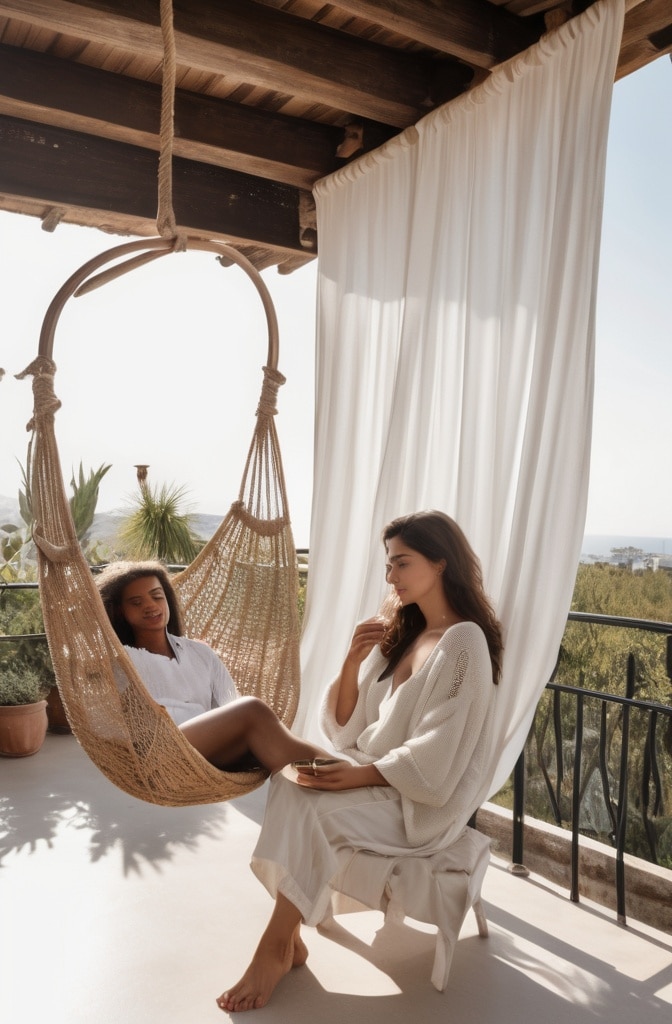
Before diving into styling techniques, understanding the different types of white lights available is crucial for achieving your desired aesthetic. The lights you choose set the foundation for your entire design scheme.
Warm vs. Cool White: Understanding Color Temperature
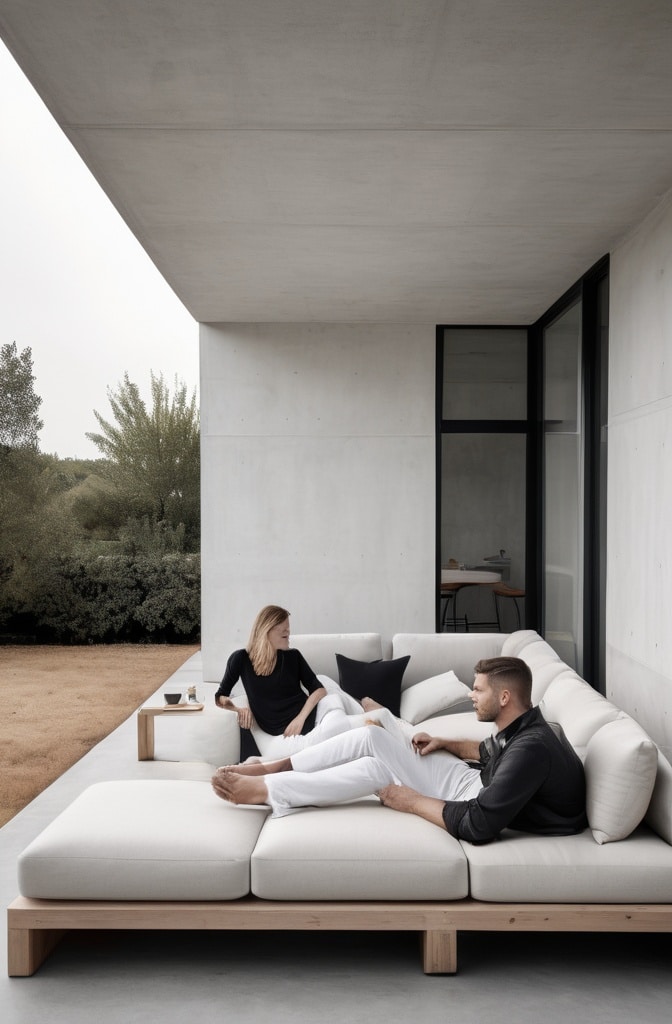
White lights aren’t simply white—they exist on a spectrum measured in Kelvins (K):
- Warm White (2700K-3000K): These lights emit a soft, yellowish glow reminiscent of traditional incandescent bulbs. They create a cozy, intimate atmosphere that pairs beautifully with gold, bronze, copper, and natural wood elements.
- Neutral White (3500K-4100K): Offering a balanced middle ground, these lights appear more naturally white without strong yellow or blue tints. They’re versatile enough to work with most color schemes.
- Cool White (5000K-6500K): These lights produce a bluish-white illumination that mimics daylight. They create a crisp, contemporary feel that enhances silver, blue, purple, and crystal decorations.
“The color temperature you choose can dramatically alter the mood of your entire room,” notes interior designer Melissa Parker. “Warm whites create intimacy in larger spaces, while cool whites can make smaller rooms feel more spacious and airy.”
LED vs. Traditional: Efficiency, Longevity and Visual Effect
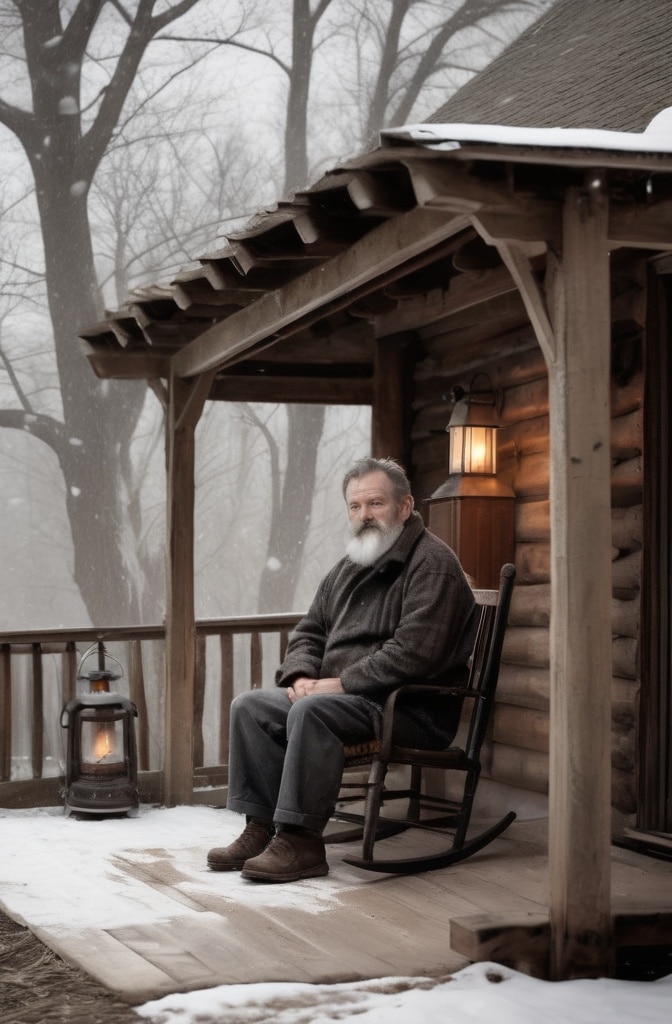
When comparing light technologies, LEDs have largely replaced incandescent options for several compelling reasons:
*Based on a 6′ tree with 600 lights used 6 hours daily throughout December (Calculated from U.S. Department of Energy data)
While LED lights cost more upfront, they typically pay for themselves within 2-3 seasons through energy savings alone. Plus, you’ll avoid the frustration of replacing burnt-out bulbs mid-season.
Types of White Light Effects
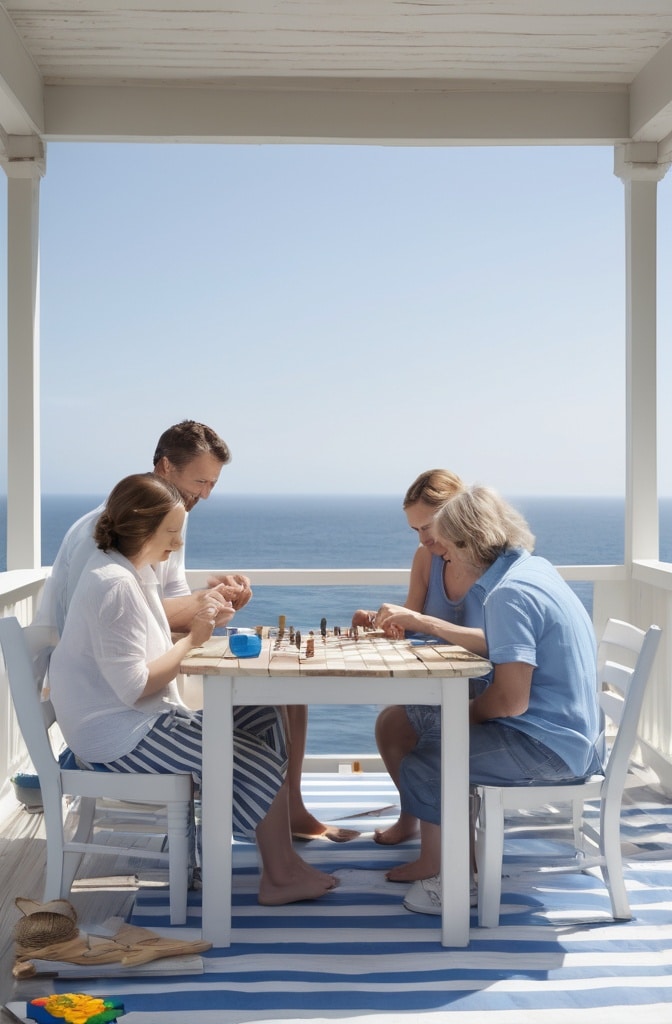
Modern Christmas lights offer various lighting effects to enhance your tree’s visual interest:
- Steady Burning: Classic continuous illumination
- Twinkling/Blinking: Lights that alternate between on and off
- Color Changing: Lights that shift between warm and cool white tones
- Wave/Chasing: Sequential lighting patterns that create movement
- Fading: Gradual dimming and brightening effects
For a classic white Christmas tree, consider combining steady lights as your base with a subtle layer of twinkling lights to add dimension without overwhelming the senses.
Light Density Recommendations
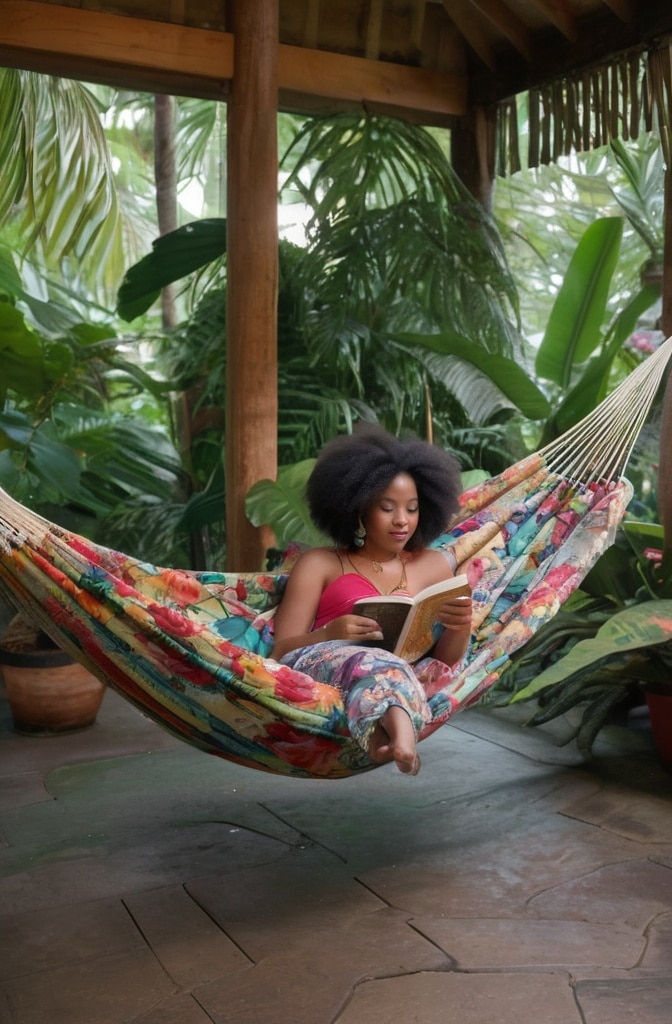
Professional decorators follow this formula for optimal light coverage:
- Minimal lighting: 50-75 lights per foot of tree height
- Moderate lighting: 100 lights per foot (standard recommendation)
- Maximum impact: 150-200 lights per foot for a truly radiant display
For example, a 7-foot white tree would need approximately 700 lights for standard coverage or up to 1,400 lights for a high-impact, luminous effect. Remember that white trees typically require 20% more lights than green trees to achieve the same perceived brightness, since the white branches reflect rather than absorb light.
II. Classic White Christmas Tree Styling Techniques
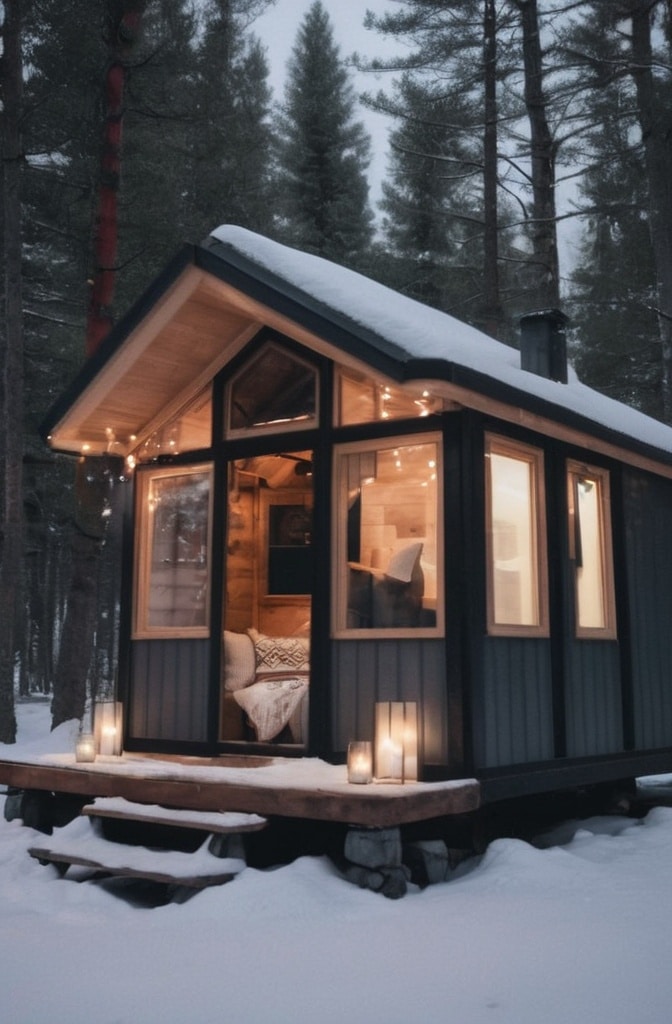
With your lights selected, it’s time to master the professional techniques that will elevate your tree from ordinary to extraordinary.
The Inside-Out Lighting Method
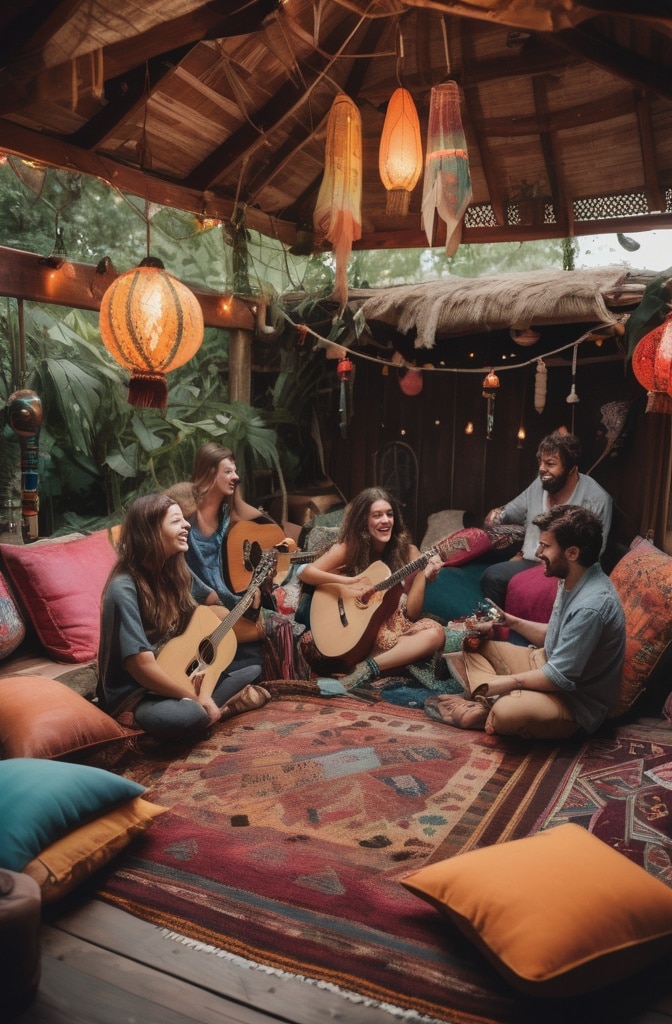
Professional decorators don’t simply wrap lights around the exterior of the tree—they work from the trunk outward in sections:
- Separate your tree into 3-4 vertical sections (like slices of pie)
- Starting at the bottom of each section, weave lights from the trunk outward along branches
- Double back toward the trunk and repeat the pattern moving upward
- Connect sections seamlessly by working in a continuous spiral
“This technique creates incredible depth because you’re illuminating the tree from within,” explains holiday stylist James Chen. “It prevents that ‘lights only on the surface’ look that’s the hallmark of amateur decorating.”
Strategic Light Placement for Depth and Dimension
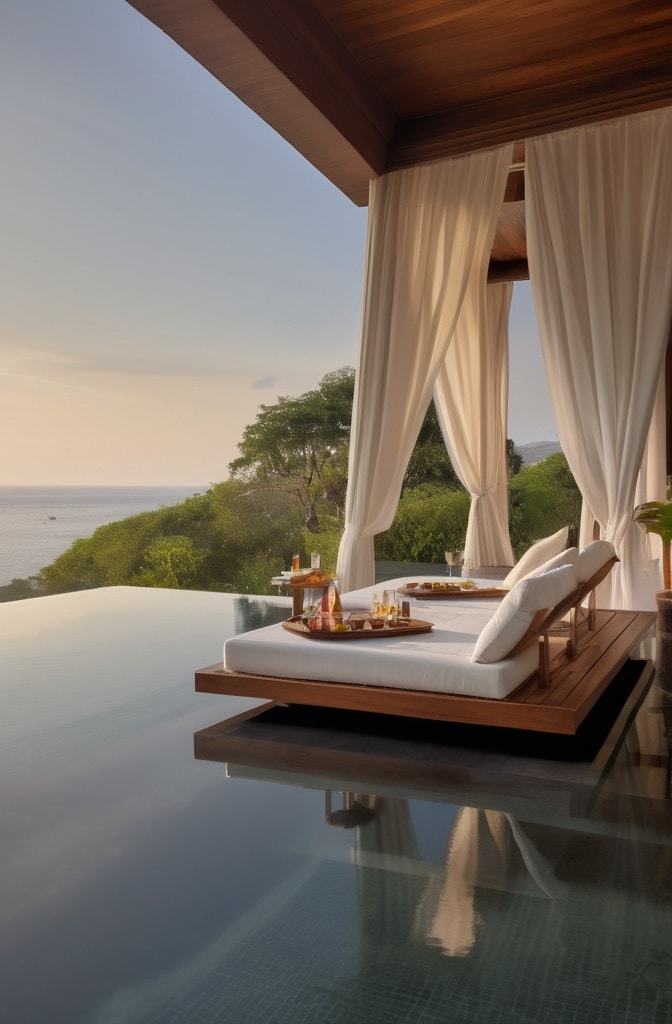
To create visual interest throughout your white tree:
- Position some lights deeper inside the branches near the trunk
- Place others at the mid-point of branches
- Bring some all the way to the tips of branches
- Focus extra lights in natural “pockets” or gaps between branches
This multi-layered approach creates a three-dimensional lighting effect that draws the eye throughout the tree rather than just along its surface.
Creating Visual Balance
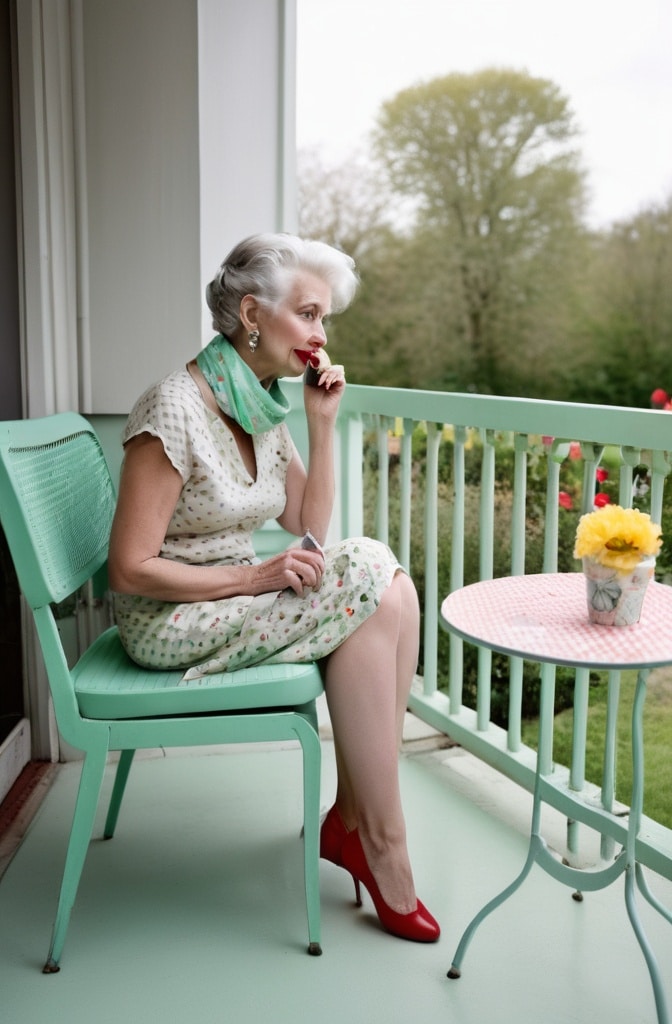
Even distribution of lights is crucial for a polished look:
- Step back frequently to assess your progress from different angles
- Squint your eyes to identify overly bright or dark areas
- Pay special attention to the upper third of the tree, which often gets neglected
- Ensure the tree appears evenly lit when viewed from all sides (unless positioned against a wall)
Common Mistakes to Avoid

- Inadequate lighting: Underestimating how many lights you need is the most frequent error
- Exterior-only placement: Failing to place lights deep within the branches
- Uneven distribution: Concentrating too many lights in easily accessible areas
- Visible cords: Not taking time to hide green or white cords among branches
- Poor planning: Running out of lights before reaching the top of the tree
III. Elegant White & Gold Theme: Creating Luxurious Warmth
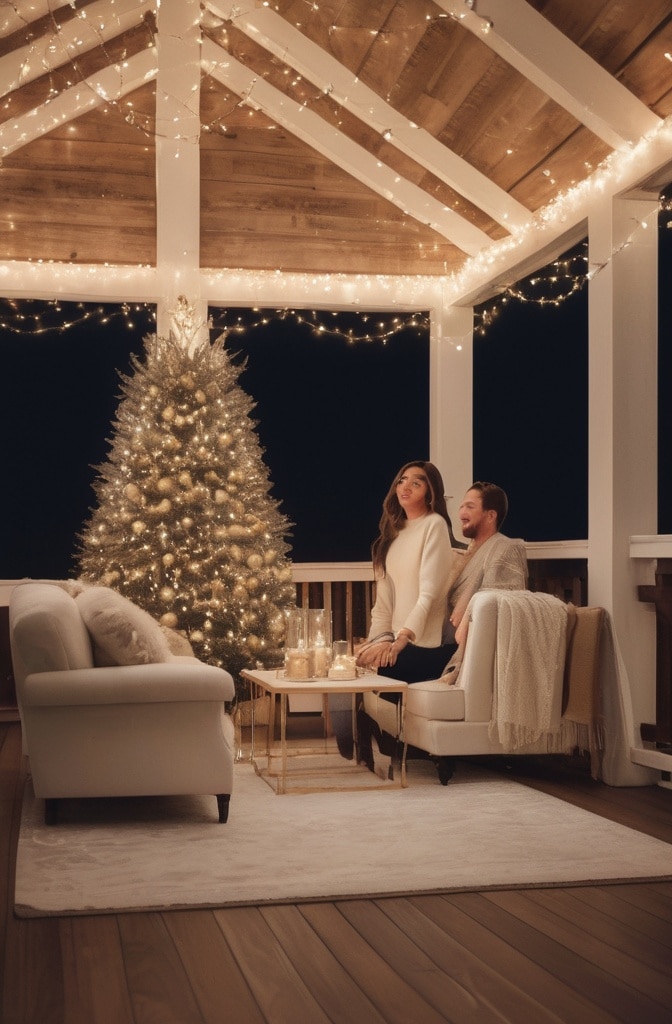
Perhaps the most timeless and sophisticated color scheme for a white Christmas tree combines warm white lights with gold accents. This pairing creates a luxurious atmosphere that feels both festive and refined.
Pairing Warm White Lights with Metallic Gold Ornaments
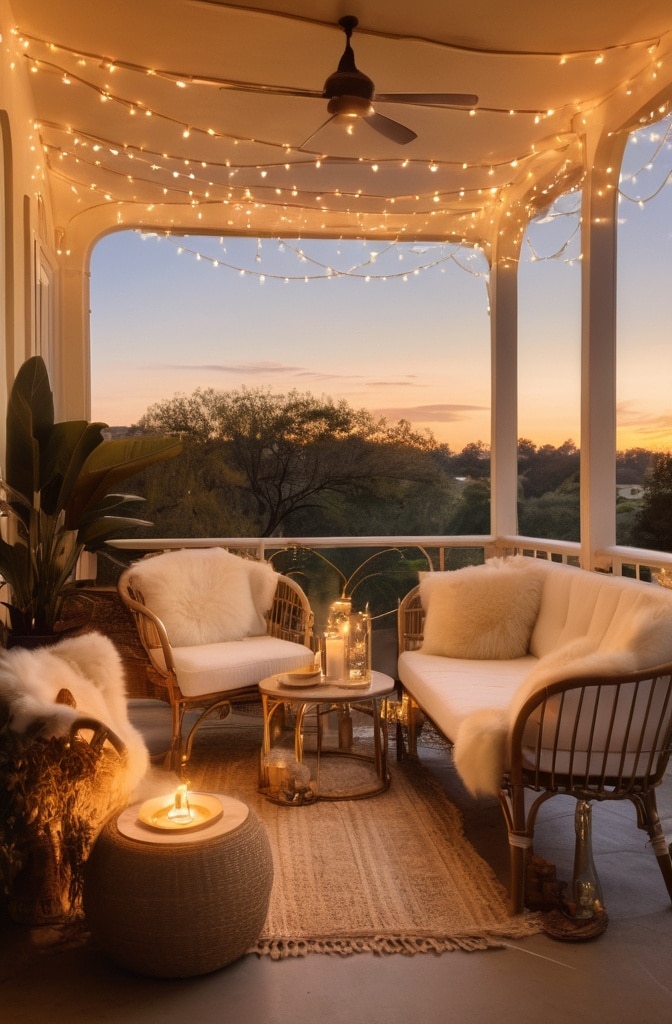
Start with a base of warm white lights (2700-3000K) using the inside-out method described earlier. Then incorporate gold elements in varying shades and textures:
- Champagne gold (lighter, more subtle)
- Classic yellow gold (traditional and rich)
- Rose gold (for a contemporary twist)
- Antique or burnished gold (adds vintage character)
Designer tip: Use larger ornaments in your dominant gold shade and smaller accents in complementary metallic tones.
Incorporating Textural Elements
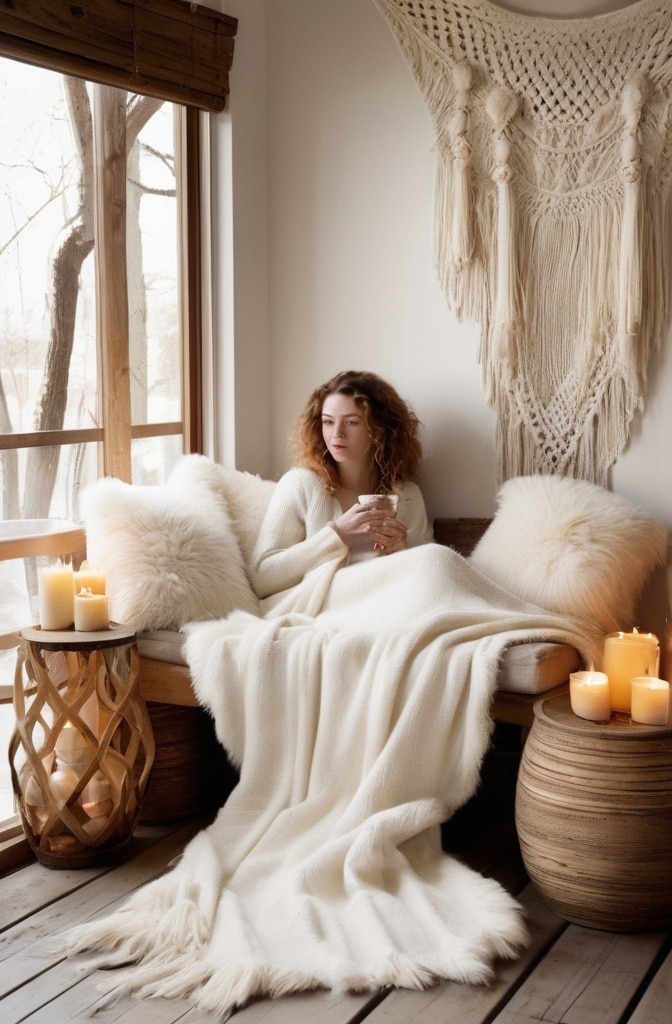
To prevent a flat, one-dimensional look, vary textures throughout your tree:
- Velvet ribbons cascading from top to bottom
- Beaded garlands wrapped in loose spirals
- Glittered ornaments interspersed with matte finishes
- Gold mesh ribbon tucked into branches to create depth
- Metallic pine cones, leaves, or floral picks
“Texture is what makes a monochromatic or two-tone tree come alive,” says holiday designer Rebecca Santos. “With white and gold specifically, aim for at least five different textures to create visual richness.”
Gold Accent Placement Strategies
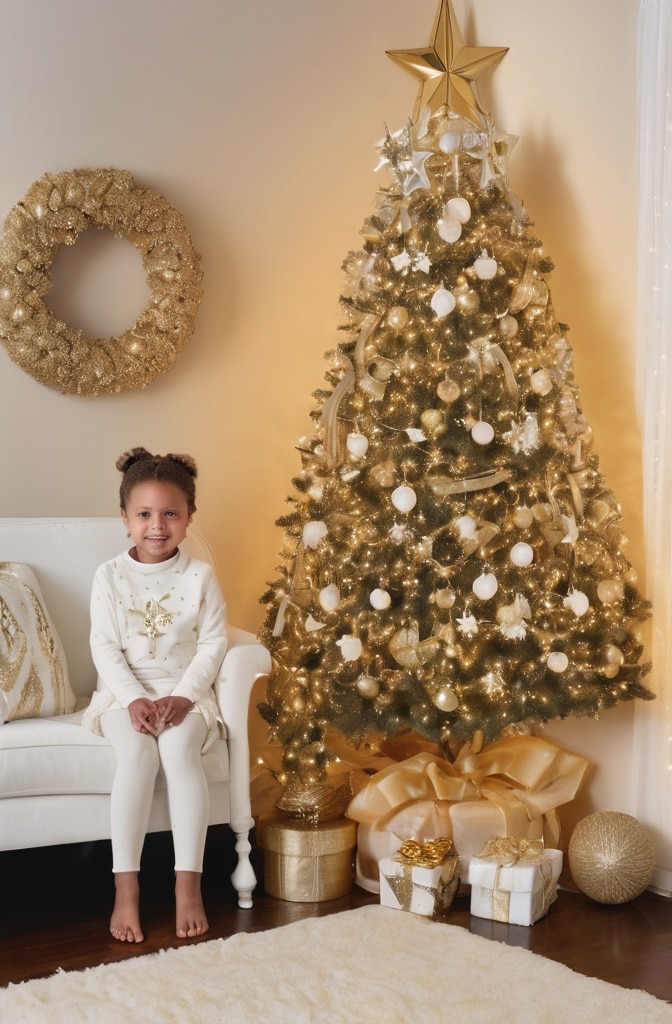
Rather than randomly hanging gold ornaments, consider these strategic placement techniques:
- Create a subtle ombré effect with darker gold tones at the bottom transitioning to lighter golds near the top
- Establish a visual “path” of gold that spirals around the tree
- Cluster similar ornaments in groups of three at varying depths
- Position larger statement pieces first as focal points, then fill in with smaller accents
Complementary Tree Skirt and Topper Options
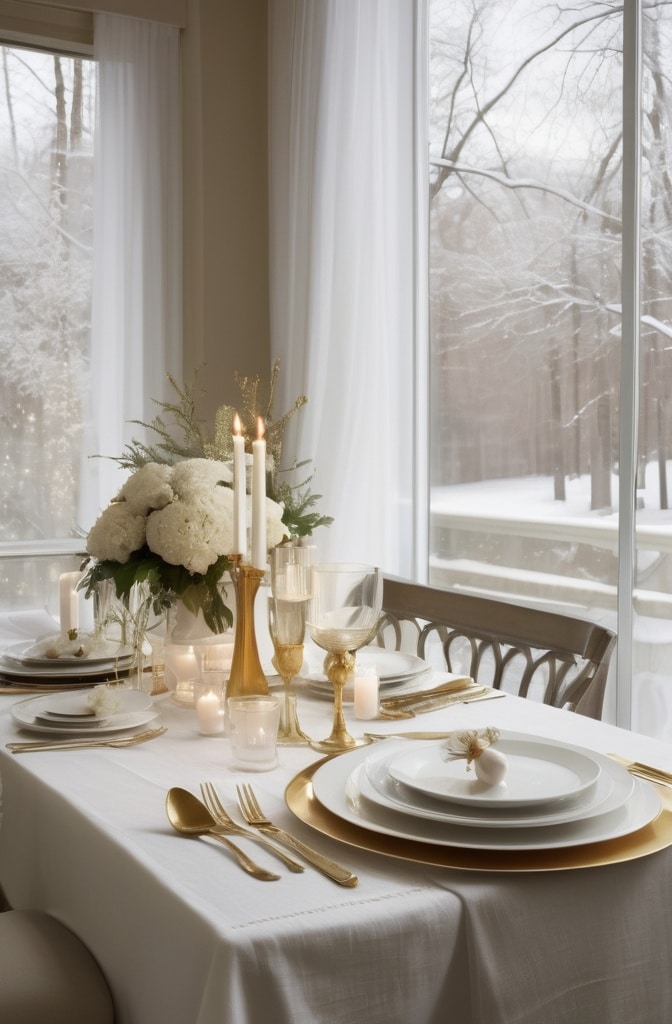
Complete your white and gold theme with:
Tree Skirt Options:
- Plush white faux fur with gold thread accents
- Gold sequined or metallic fabric
- Cream-colored velvet with gold embroidery
- Woven jute or burlap with gold metallic threads
Tree Topper Options:
- Illuminated gold starburst
- Angel figure with gold accents
- Oversized gold bow with cascading ribbons
- Cluster of gold branches or floral elements
IV. Frosted Winter Wonderland: Cool White & Silver Theme
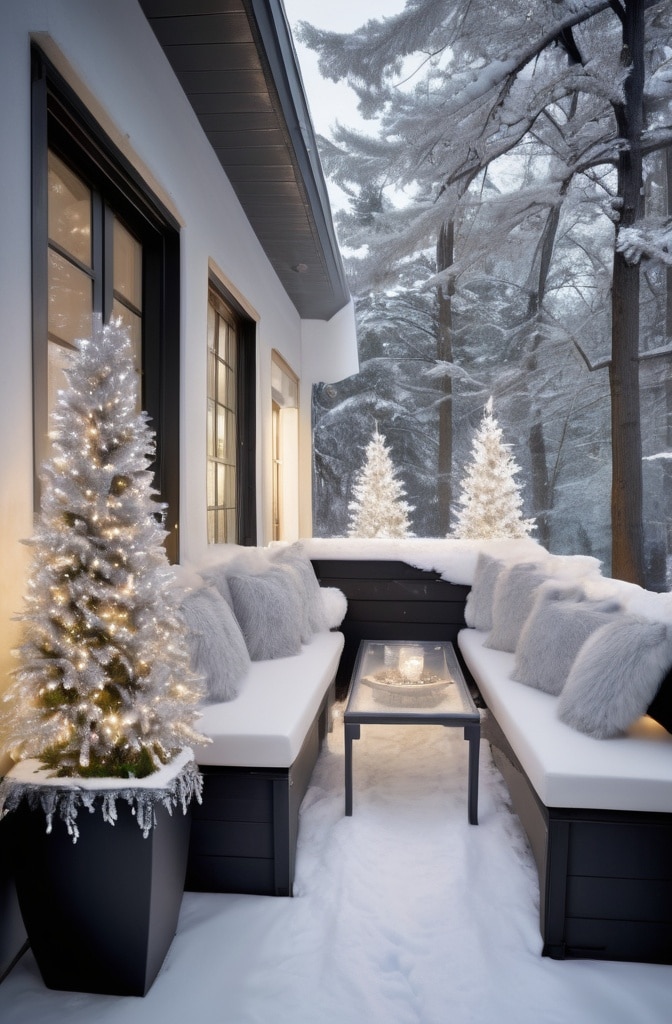
For a crisp, contemporary winter wonderland effect, cool white lights paired with silver and crystal elements create magical results on a white tree.
Using Cool White Lights to Enhance the “Snow-Kissed” Effect
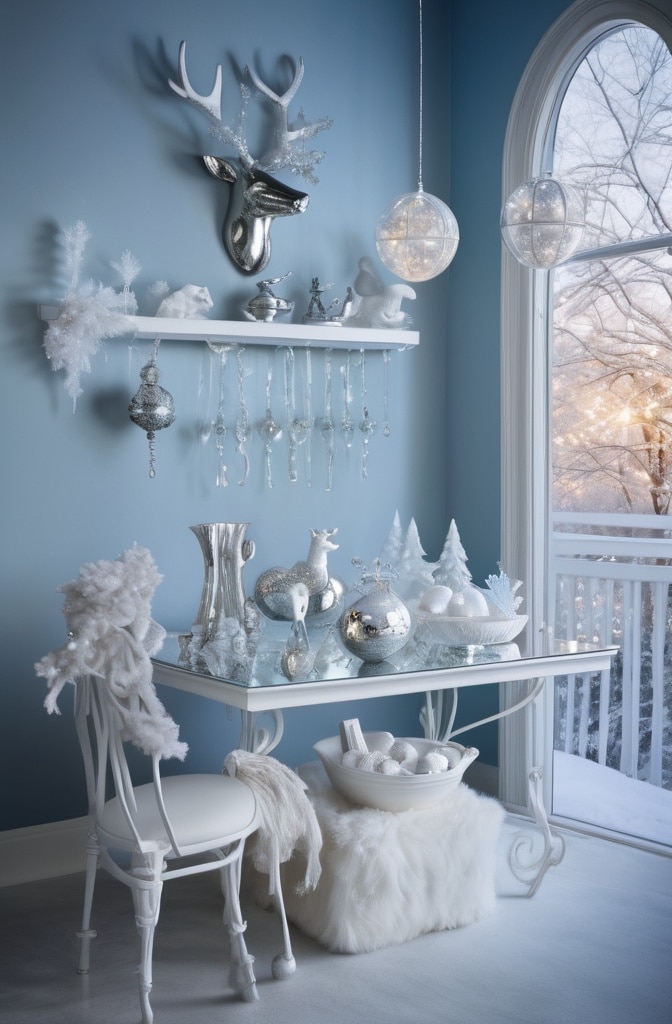
Cool white lights (5000K-6500K) naturally enhance the snowy appearance of white branches. To maximize this effect:
- Use LED lights with a bluish undertone
- Consider lights with a subtle blue-shift effect
- Layer in some twinkling cool white lights to mimic starlight
- Add cluster lights or “fairy lights” on copper wire for concentrated glow points
Techniques for Incorporating Frosted Ornaments and Icicle Elements

To build on the icy theme:
- Hang crystal or glass icicle ornaments at varying heights
- Position frosted glass balls of different sizes throughout the tree
- Add dangling snowflakes that catch and reflect the light
- Incorporate silver lametta tinsel for delicate shimmer
“The key to a sophisticated frosted look is restraint with the right elements,” advises designer Thomas Walsh. “You want to suggest ice and snow through selective, quality pieces rather than overwhelming the tree.”
Adding Dimension with Crystal and Mirrored Accents

Reflective elements multiply the impact of your lighting:
- Mirrored ball ornaments reflect light throughout the tree
- Crystal prisms create rainbow light effects when positioned near lights
- Mercury glass ornaments add vintage appeal while reflecting light
- Small mirrors tucked into inner branches create unexpected light play
Creating Subtle Blue Undertones
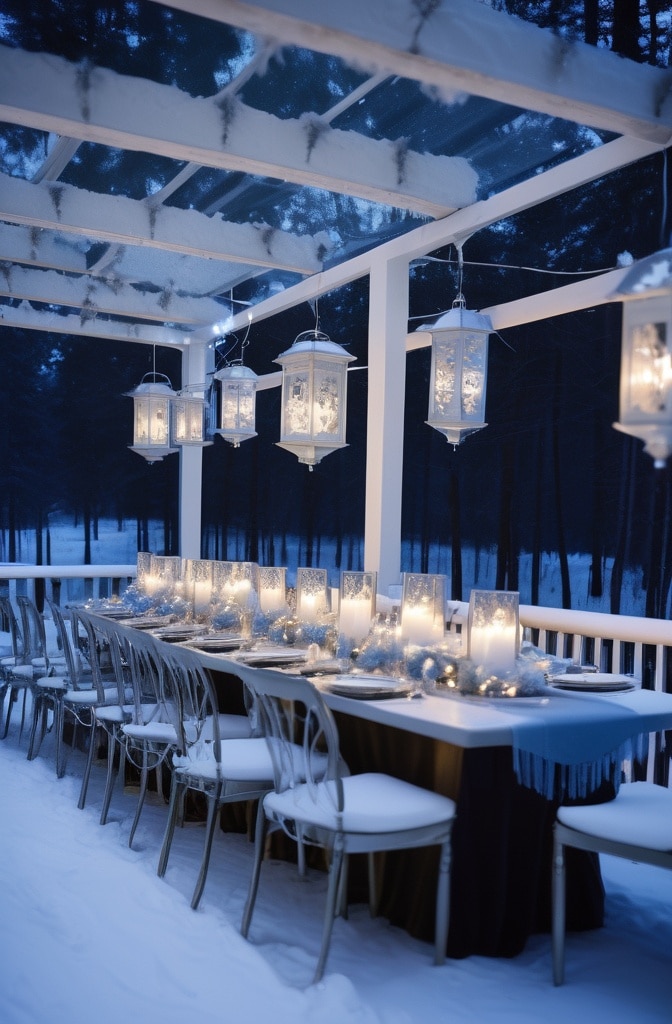
While maintaining a primarily silver and white palette, hints of pale blue add depth:
- Barely-blue transparent ornaments
- Pale blue-silver ribbon
- Frosted ornaments with the slightest blue tint
- Blue-white LED lights mixed with standard cool white
DIY Frosting Techniques
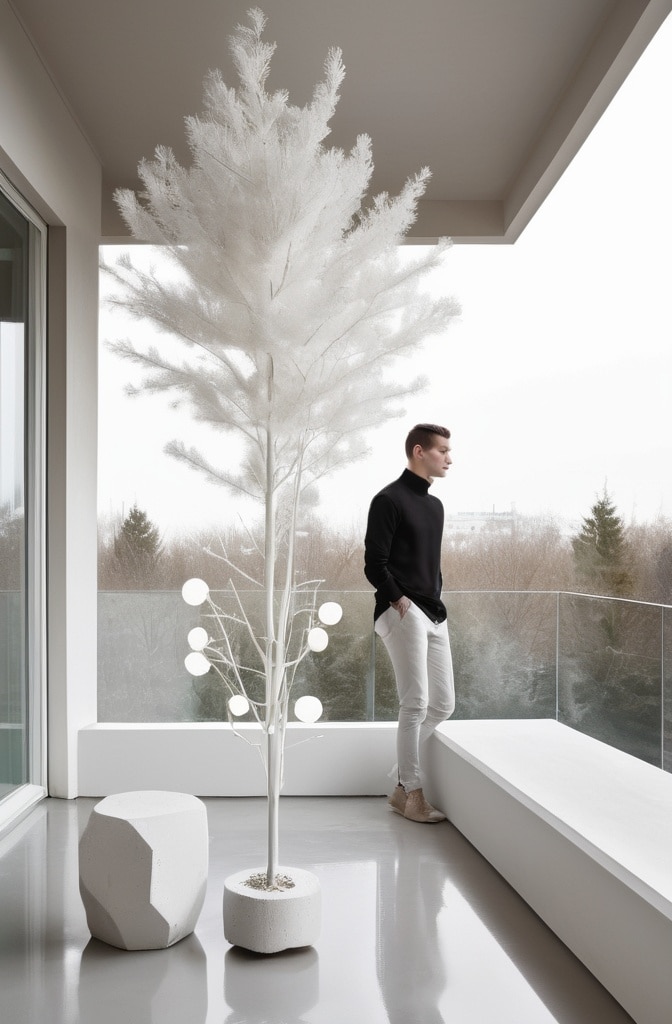
Create custom frosted elements with these simple techniques:
- Basic Epsom Salt Frosting:
- Coat ornaments with white craft glue
- Roll in Epsom salts
- Allow to dry completely
- Faux Snow Spray:
- Apply to branches and pinecones
- Layer lightly for a more natural effect
- Glass Ornament Frosting:
- Swirl floor wax inside clear glass ornaments
- Drain excess and allow to dry for a permanent “frosted” interior
V. Minimalist White Christmas Tree Styling
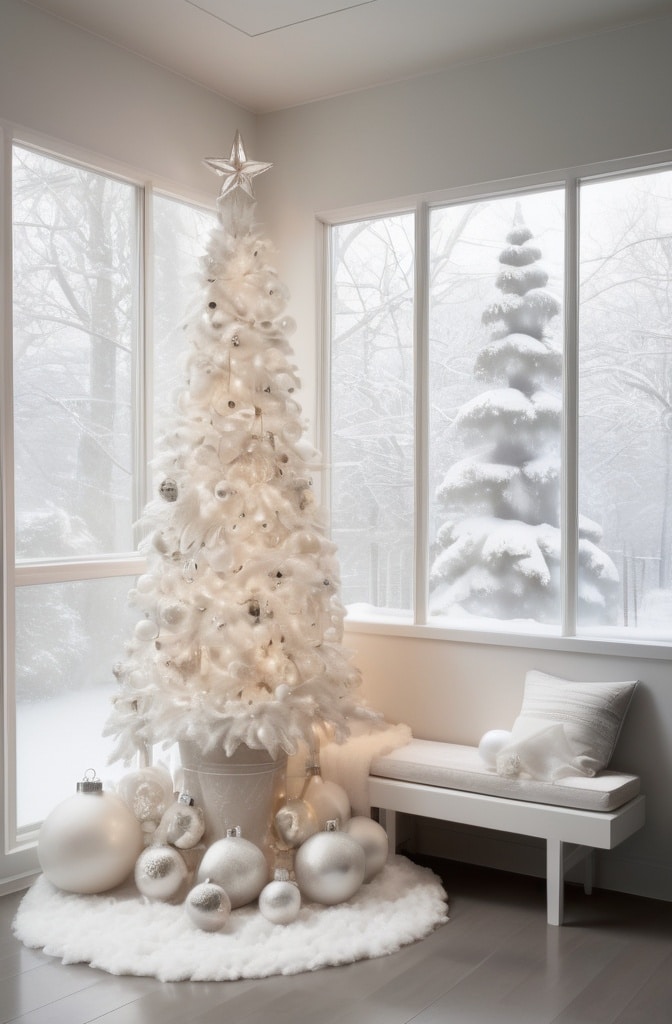
The minimalist approach celebrates elegant simplicity through careful curation and intentional design. This style has gained popularity as a sophisticated alternative to traditional abundant decorating.
The “Less is More” Approach
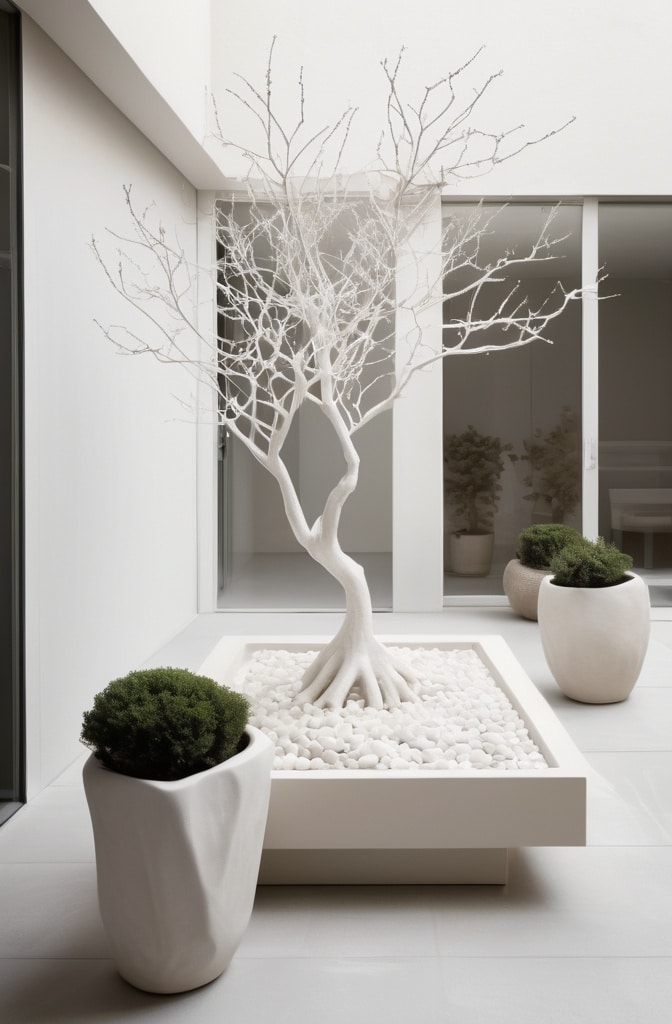
Minimalist styling doesnt mean sparse or boring—it means purposeful:
- Focus on quality over quantity
- Maintain plenty of negative space between elements
- Select a limited color palette (usually just 2-3 colors)
- Choose ornaments with simple, clean lines
- Aim for asymmetrical balance rather than perfect symmetry
Research from interior design studies suggests that minimalist holiday décor can actually reduce stress levels by creating a sense of order and calm during an otherwise hectic season.
Monochromatic Layering Techniques
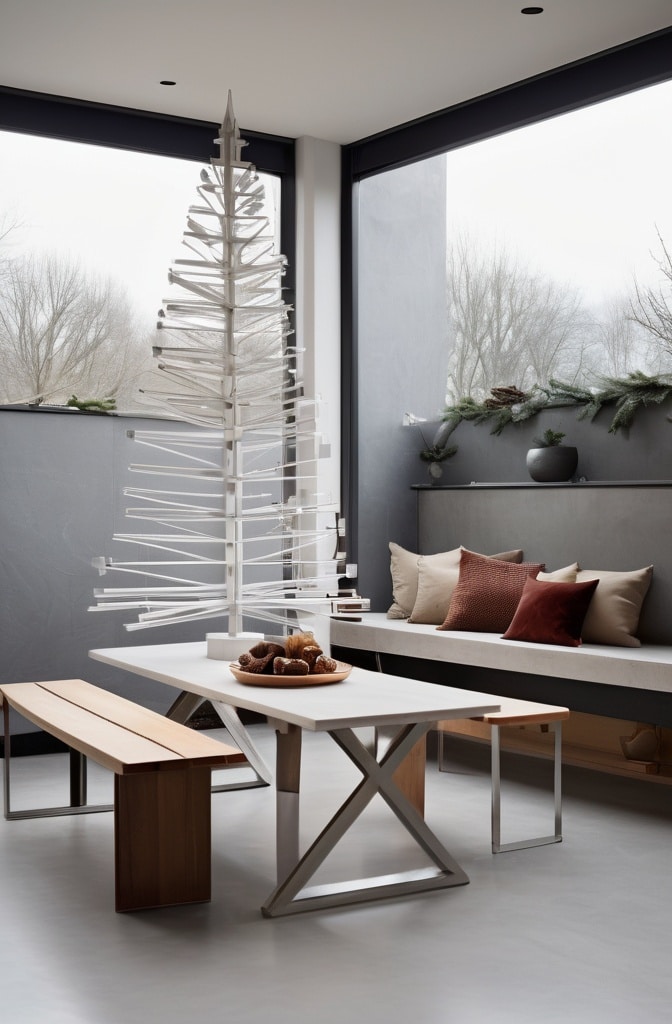
Create depth while maintaining minimalism through tonal variations:
- Layer pure white, cream, ivory, and pearl finishes
- Mix matte, satin, and high-gloss surfaces in the same color family
- Incorporate white ornaments with subtle patterns or textures
- Add dimension through varying shapes rather than colors
Incorporating Negative Space
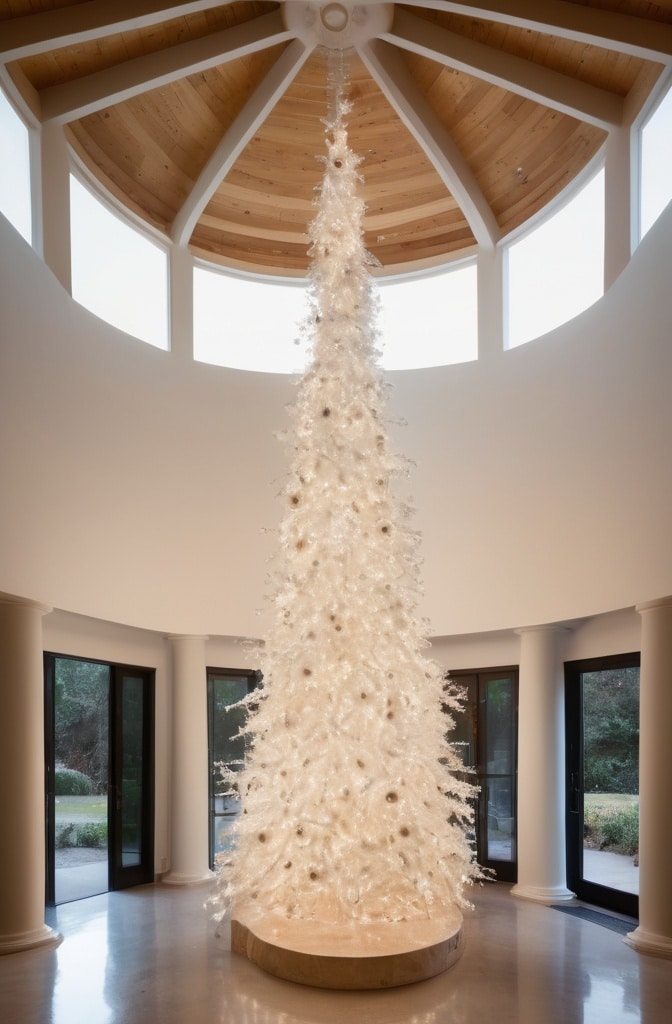
Unlike traditional decorating that aims to fill every gap, minimalist styling embraces empty space:
- Leave deliberate gaps between ornament clusters
- Allow some branches to remain completely unadorned
- Create focal areas with light concentration, leaving other areas more subtle
- Consider decorating only the outer tips of branches for a contemporary silhouette
Modern, Clean-Lined Toppers and Tree Stands
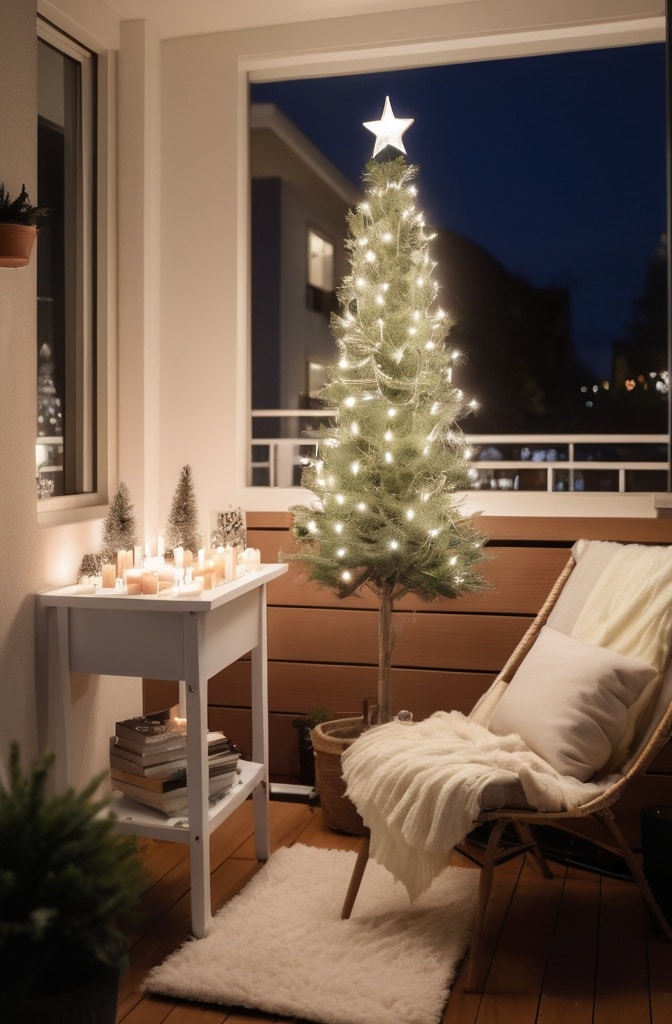
Complete the minimalist look with:
Topper Options:
- Single large star with clean geometric lines
- Simple metal or wooden geometric shape
- Small cluster of thin metallic branches
- No topper at all (increasingly popular in modern styling)
Tree Stand Solutions:
- White ceramic pot or planter
- Simple white wooden box
- Metal stand with clean lines
- White tree collar with minimal detailing
VI. Specialized Styling Solutions
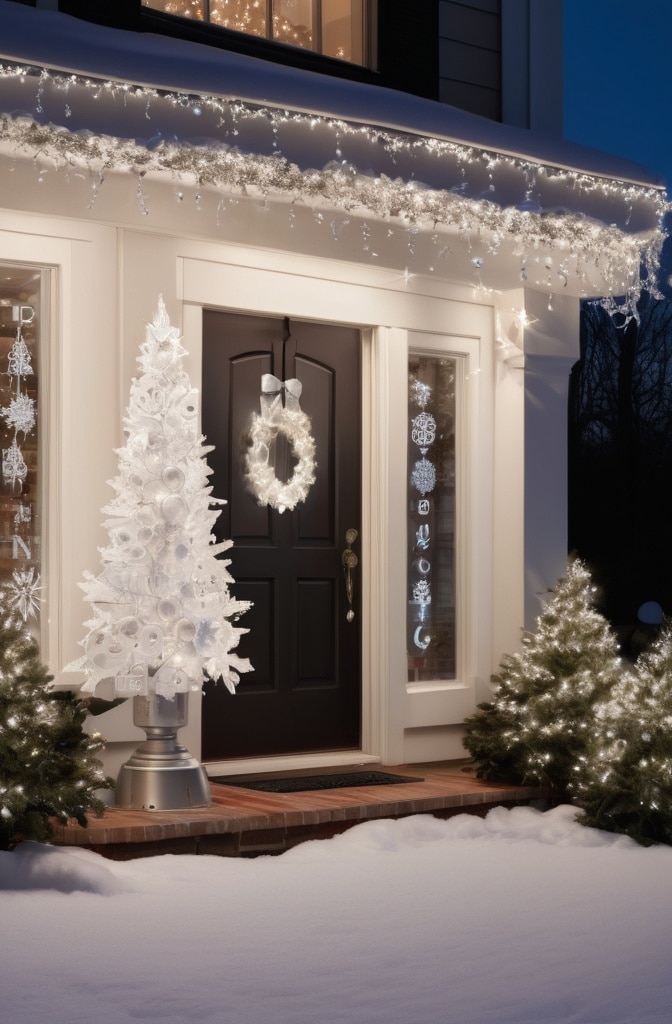
Different trees and spaces present unique challenges that require specialized approaches.
Tall Trees: Proper Light Distribution and Visual Scaling
For trees over 8 feet tall:
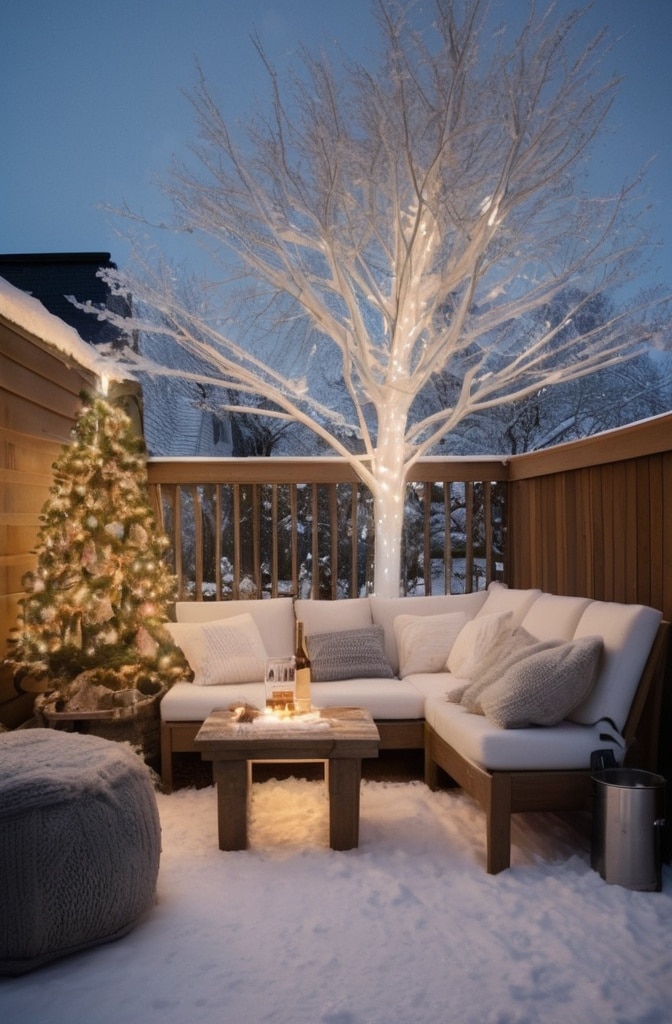
- Increase light density by 20% (120 lights per foot minimum)
- Use larger ornaments at the bottom, gradually decreasing size toward top
- Create horizontal visual “breaks” every 2-3 feet with ribbon or garland
- Consider a multi-part lighting strategy with separate light strings for top, middle, and bottom sections
- Place a spotlight under the tree pointing upward to eliminate dark spots near the trunk
According to professional holiday installers, tall trees benefit from having approximately 25% more lights in their upper third to compensate for the visual weight of the wider bottom sections.
Small Spaces: Creating Impact with Limited Square Footage
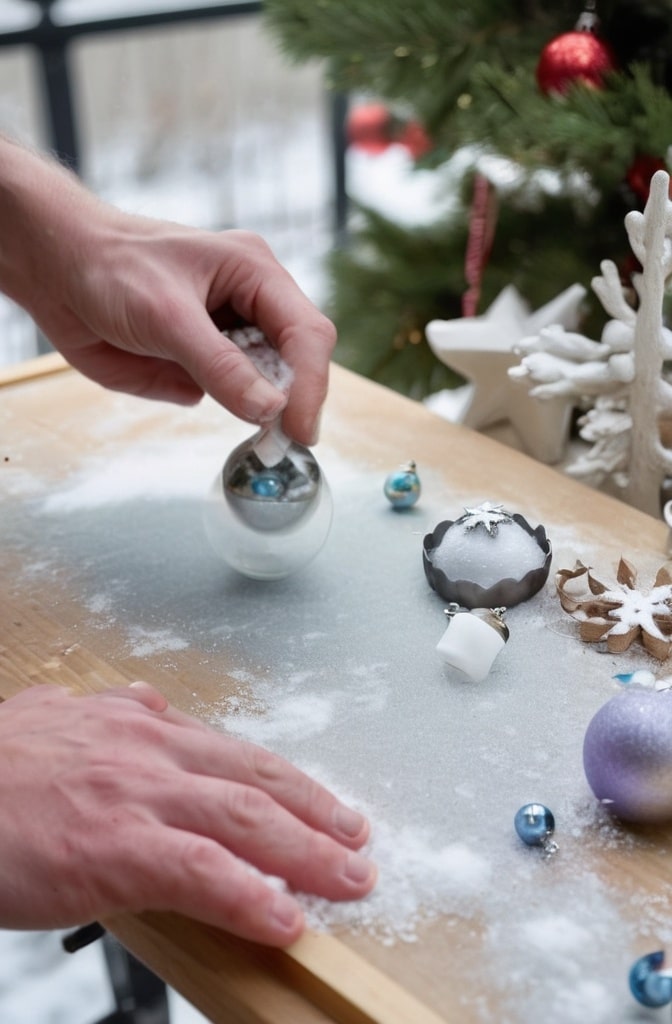
When working with limited space:
- Choose slender pencil trees or half/quarter trees that sit flush against walls
- Use micro LED lights that provide brightness without visual bulk
- Select a deliberate color scheme with no more than two colors
- Opt for ornaments that are flat or have visual interest from limited viewing angles
- Consider a small tabletop tree elevated on a side table to maximize floor space
“Small space trees should be viewed as jewelry for your room—delicate, intentional, and making an impact beyond their size,” suggests small-space designer Nina Takesh.
Pre-Lit Trees: Enhancing and Customizing Factory Lighting
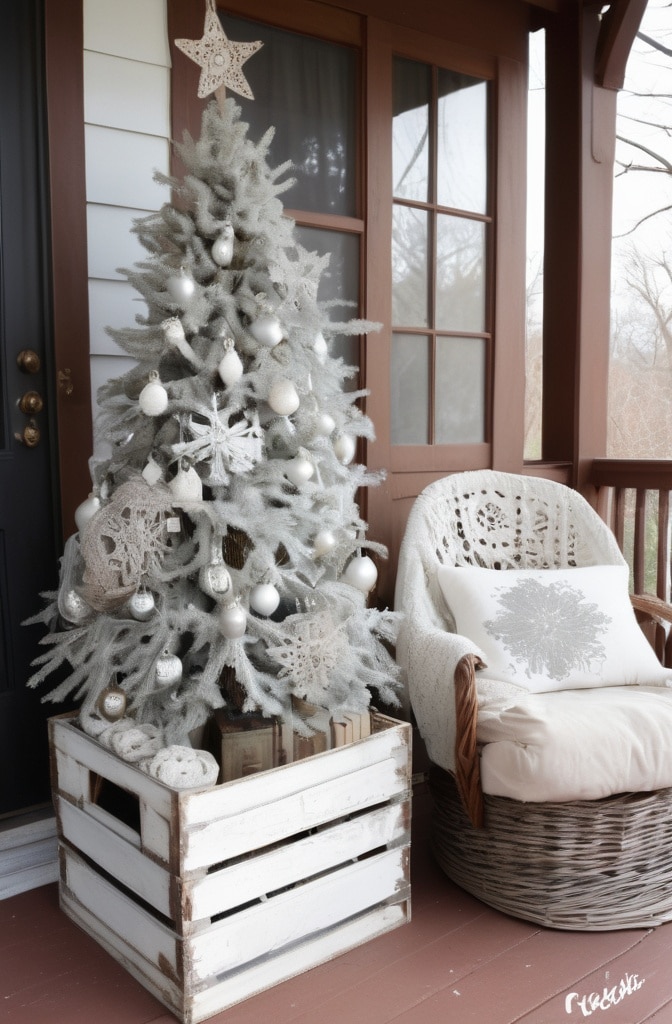
To elevate a pre-lit white tree:
- Supplement factory lights with additional strands in complementary temperature
- Add battery-operated micro lights to inner branches for depth
- Use light clips to reposition factory lights where needed
- Consider ribbon with metallic threading to reflect existing lights
- Focus ornament placement where factory lighting is strongest
Recent improvements in pre-lit tree technology have significantly enhanced quality, with premium models now offering color-changing options that transition from warm to cool white.
Outdoor White Trees: Weatherproofing Considerations
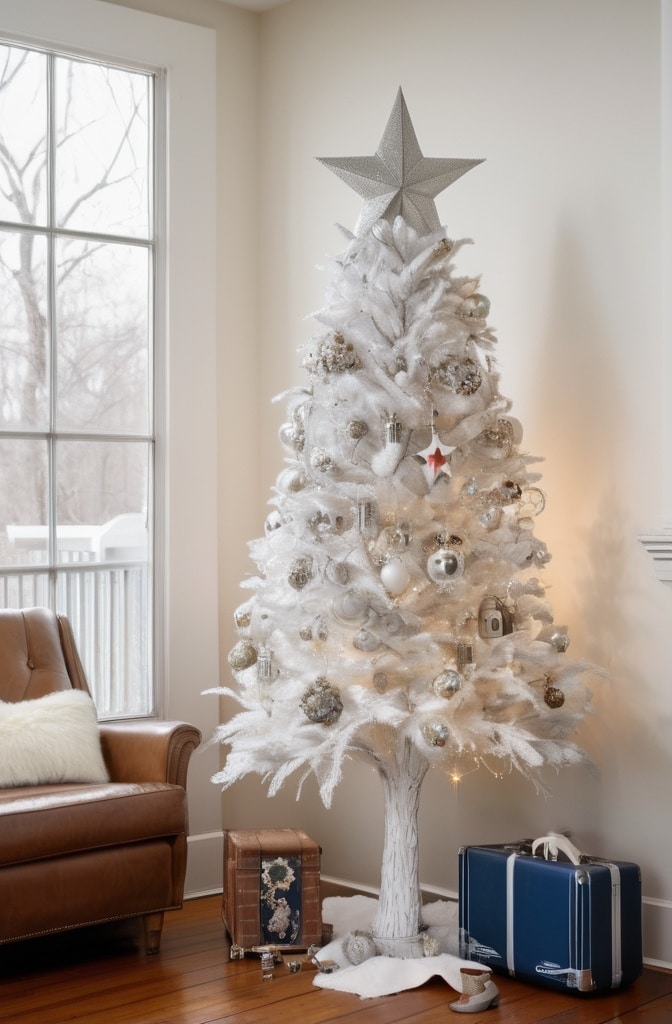
For exterior white tree displays:
- Use only UL-listed outdoor lights rated for exterior use
- Select shatterproof ornaments made from acrylic or plastic
- Apply weather-resistant clear spray to fabric decorations
- Choose a tree with UV-resistant branches to prevent yellowing
- Consider battery or solar options to eliminate extension cords
Weather-resistant white trees have become increasingly sophisticated, with some models able to withstand temperatures from -10°F to 100°F without showing wear.
Vintage-Inspired Trees: Incorporating Heirloom Elements

To create a nostalgic feel with modern white trees:
- Use reproduction C7 or C9 bulbs (the larger, traditional shape)
- Incorporate bubble lights for true vintage charm
- Display family heirloom ornaments in prominent positions
- Add tinsel garland draped in vertical lines
- Include classic glass reflectors and indent ornaments
“Vintage styling on a white tree creates a wonderful juxtaposition between old and new,” notes holiday historian Caroline Mitchell. “It showcases heirloom ornaments even more effectively than traditional green trees.”
VII. Advanced Techniques for Lighting Artistry
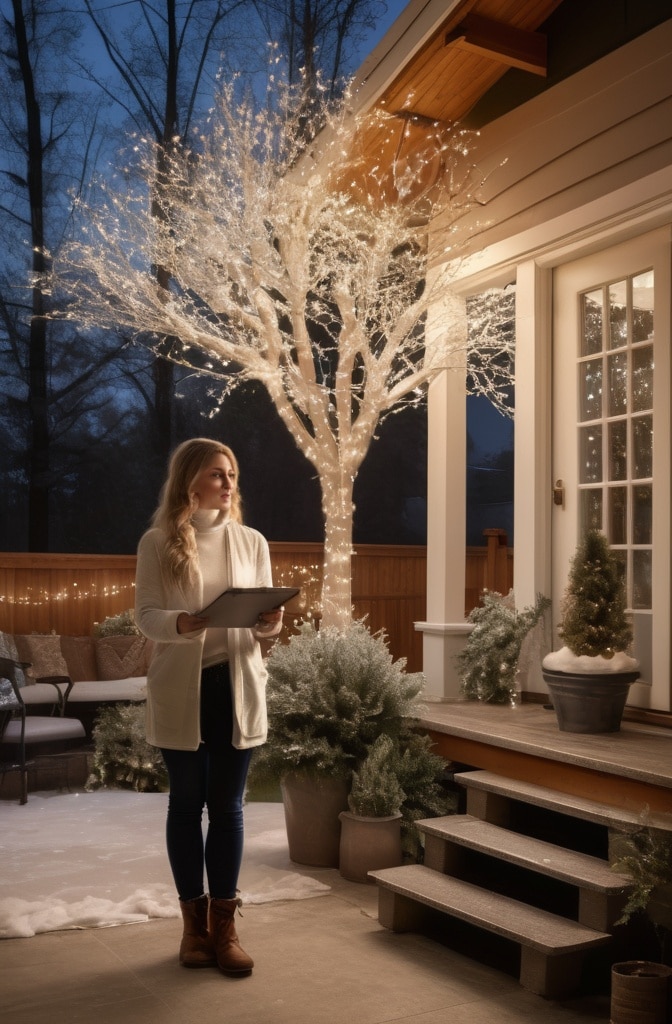
Once you’ve mastered the basics, these advanced techniques will elevate your white Christmas tree to professional levels.
Branch Wrapping Methods for Professional-Looking Results

Instead of simply draping lights, try these specialized techniques:
The Figure-Eight Wrap:
- Start at the base of individual branches
- Wrap lights in a figure-eight pattern moving outward
- Focus on main, structural branches
- Creates beautiful light definition without visible cords
The Branch Highlight Technique:
- Identify 10-15 “feature branches” throughout the tree
- Wrap these completely with extra lights
- Leave surrounding branches with standard lighting
- Creates dramatic depth and focal points
Layering Lights with Sheers and Translucent Materials
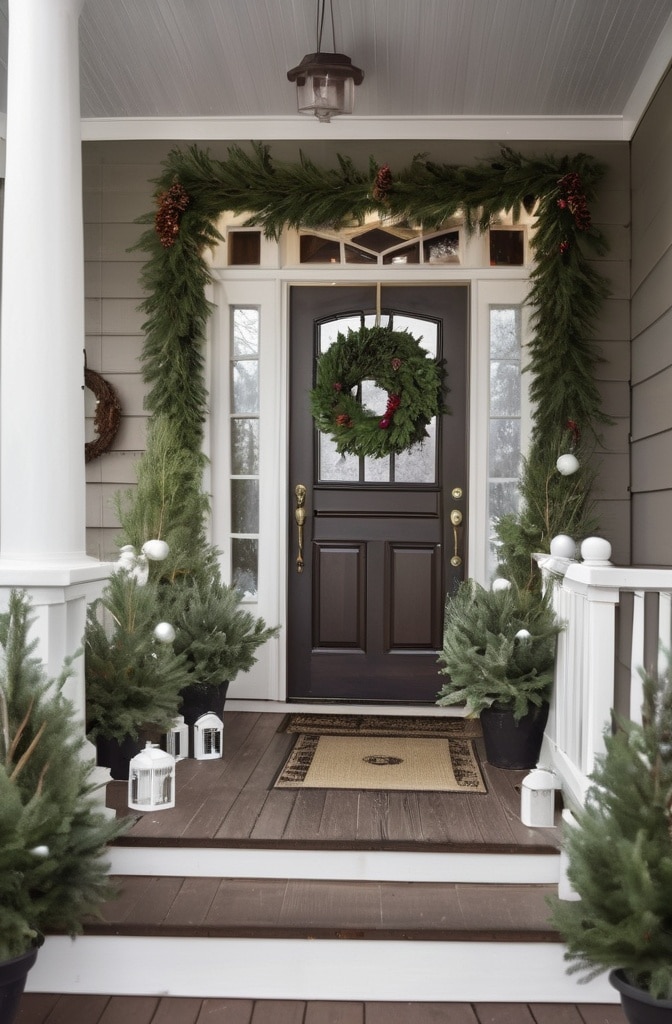
Create magical diffusion effects by combining lights with:
- Sheer organza ribbon woven through branches
- Translucent paper snowflakes positioned over lights
- Gossamer fabric tucked into inner branches
- Iridescent cellophane shaped into loose “nests” around light clusters
These materials soften and spread light, creating ethereal glowing pockets throughout the tree.
Integrating Natural Greenery with White Elements
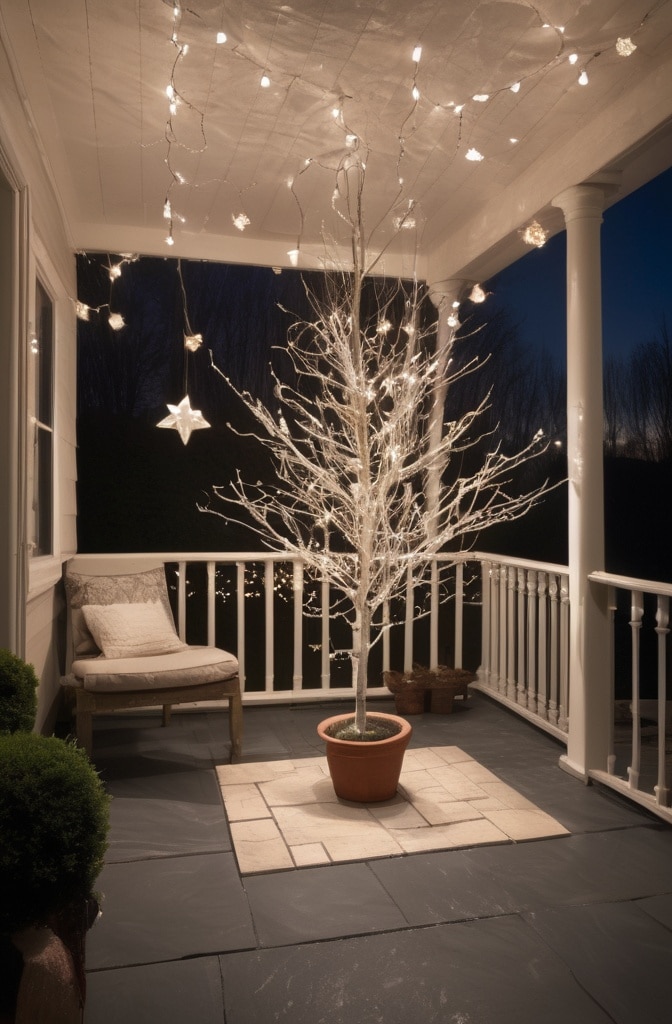
The contrast of natural elements against a white tree creates striking visual interest:
- Tuck small bundles of fresh eucalyptus, cedar, or pine into the branches
- Add white-tipped pinecones throughout the tree
- Include sprays of white-painted branches or curly willow
- Position sprigs of berries (real or artificial) as color accents
Pro tip: Spritz natural elements with glycerin-water solution to extend their freshness throughout the season.
Creating Focal Points with Light Concentration

Strategically concentrate lights to draw attention to specific areas:
- Position cluster lights behind feature ornaments
- Create a “river of light” that flows from top to bottom
- Illuminate the tree’s interior core more intensely than outer branches
- Use microdot lights to highlight specific ornaments or decorative elements
Special Effects: Spotlight Highlights and Shadow Play
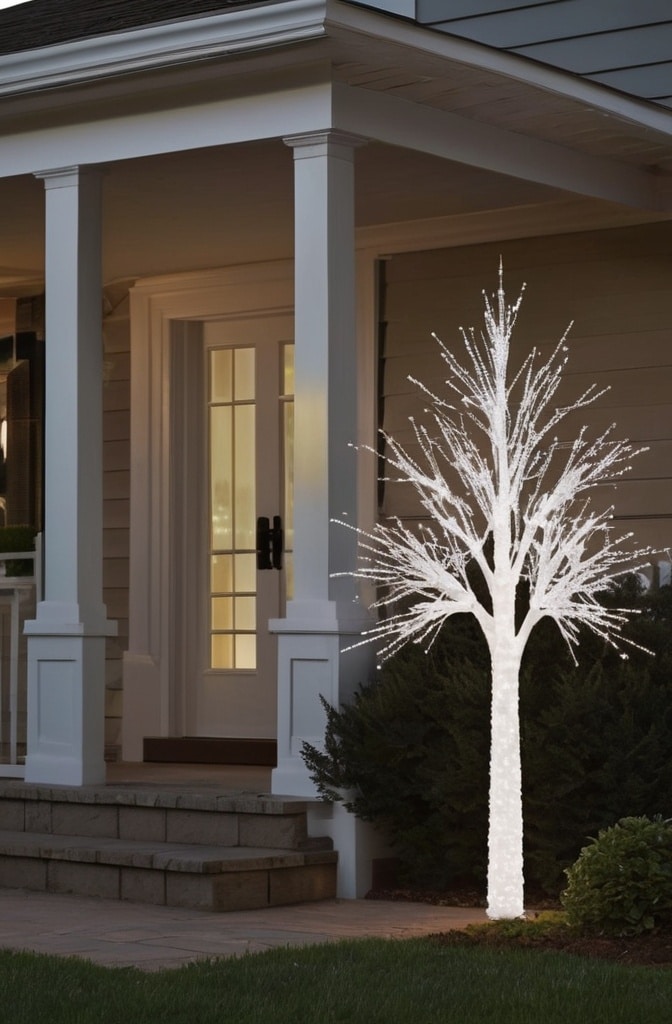
Advanced lighting can create theatrical effects:
- Position small clip-on LED spotlights to highlight special ornaments
- Create intentional shadow patterns using cut-out shapes in front of lights
- Use color-changing lights programmed to subtly shift between warm and cool white
- Experiment with projection mapping for animated effects on solid areas
VIII. Finishing Touches That Make a Difference
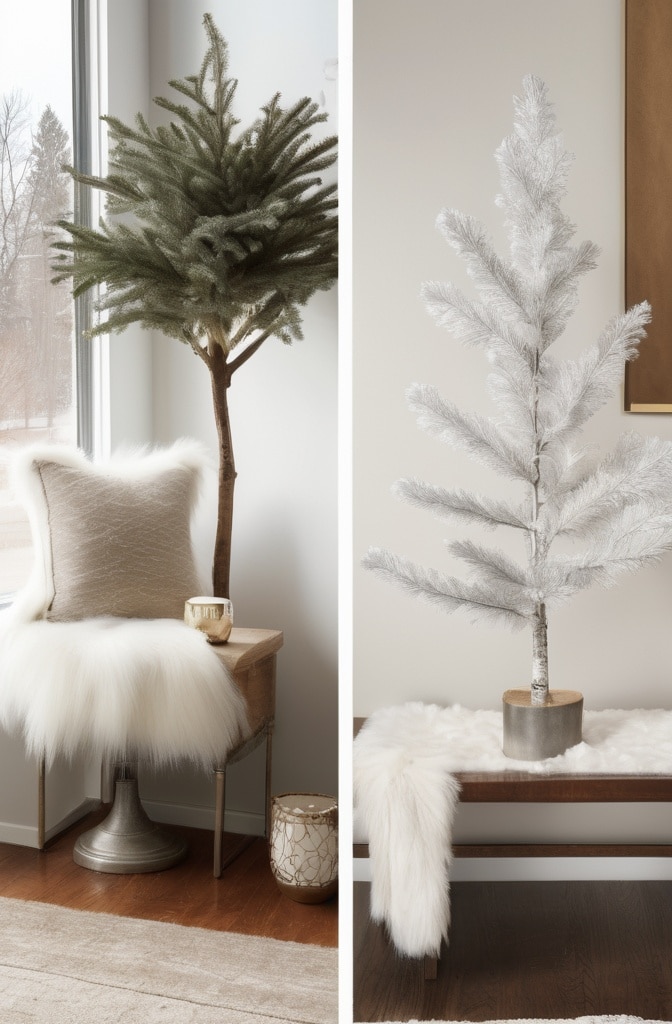
The final details often distinguish an ordinary tree from an extraordinary one.
Coordinating Tree Toppers with Your Lighting Scheme
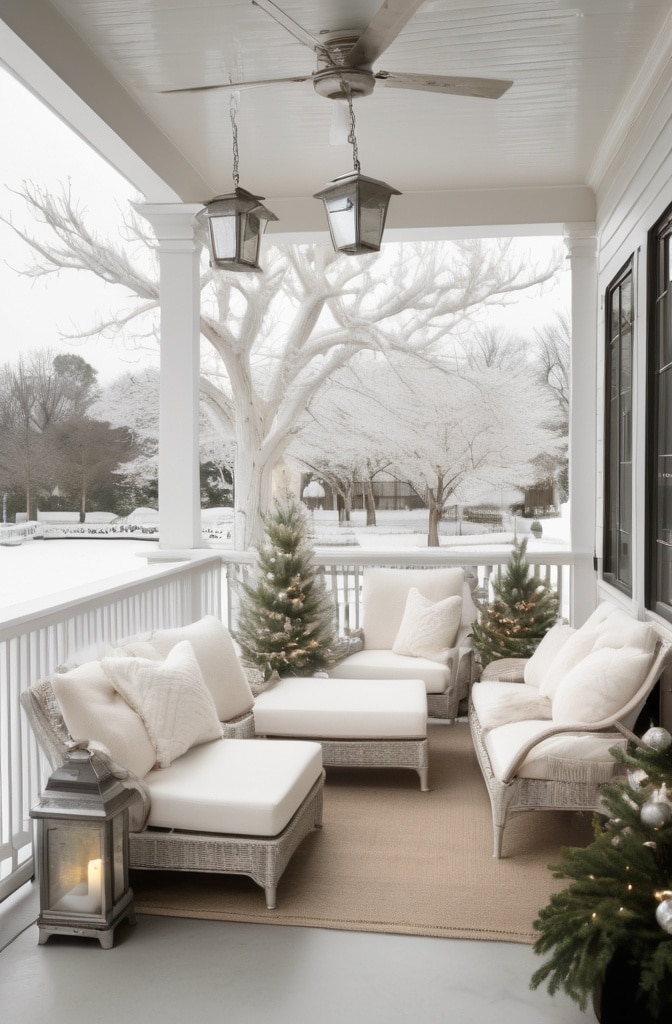
Your topper should complement both your lights and overall theme:
- For warm white themes, consider gold, copper, or amber-toned toppers
- For cool white designs, opt for silver, crystal, or white options
- Illuminated toppers should match your primary light temperature
- Consider scale—generally, toppers should be approximately 1/10 the height of your tree
Recent trends show a move toward non-traditional toppers like floral arrangements, fabric bows, or sculptural elements rather than conventional stars and angels.
Tree Skirt and Tree Collar Options
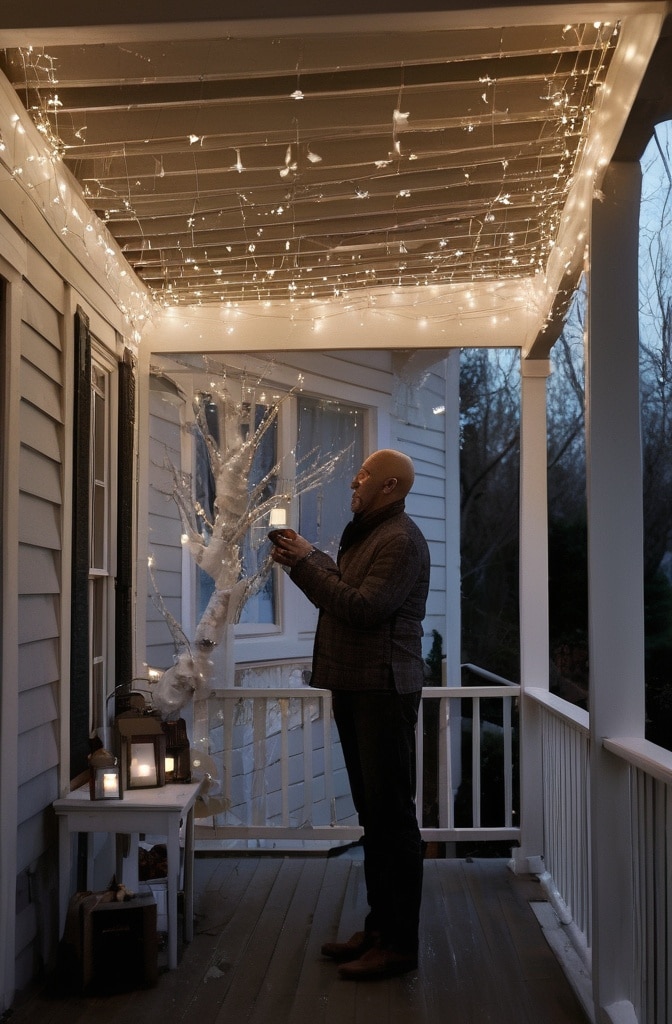
The tree base provides another opportunity to enhance your design:
For Warm White/Gold Themes:
- Plush velvet in cream or champagne
- Metallic brocade fabric
- Natural burlap with gold threading
- Wooden tree collar in whitewashed finish
For Cool White/Silver Themes:
- Faux fur in pure white
- Silver sequined fabric
- White wooden collar with snowflake cutouts
- Mirror-mosaic tree stand cover
According to holiday decorating surveys, approximately 68% of decorators are now choosing tree collars over traditional skirts, with white, wood, and metallic finishes being the most popular options.
Surrounding Décor that Complements Your White Tree
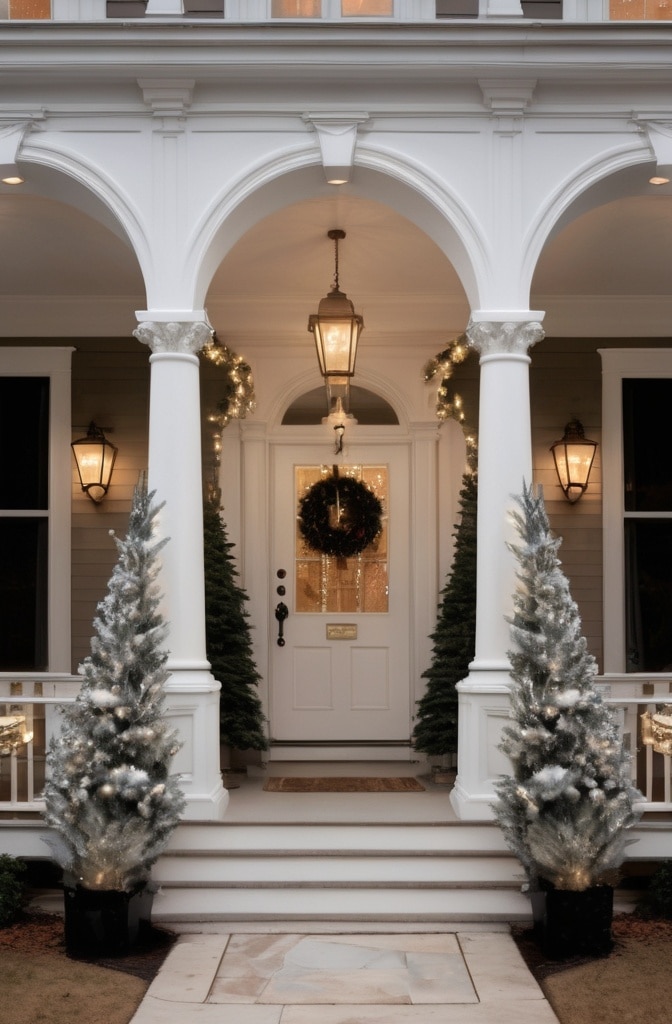
Extend your theme to the surrounding area:
- Position matching gift boxes wrapped in coordinating paper and ribbons
- Place battery-operated candles in varying heights around the tree base
- Add throws and pillows in complementary textures on nearby furniture
- Consider a small coordinating garland on adjacent mantels or shelving
Proper Placement in Your Home
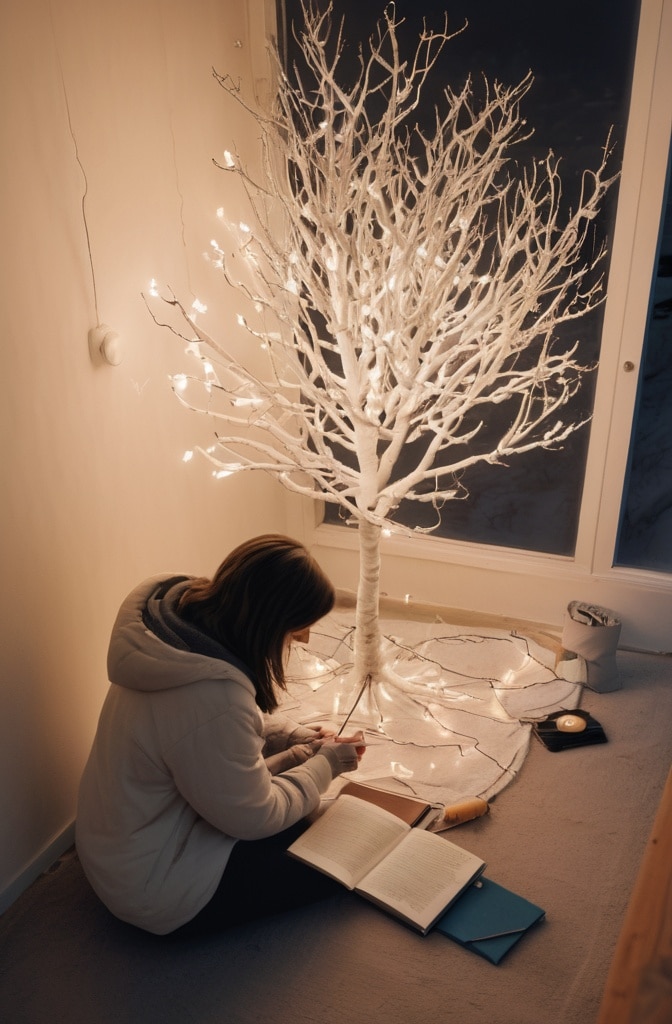
The location of your white tree significantly impacts its visual effect:
- Position against a colored wall for maximum contrast
- Avoid placing near heating vents that can cause branch drooping
- Consider corner placement with mirrors on adjacent walls to multiply the light effect
- If possible, highlight with existing recessed ceiling lights or wall sconces
“A white tree benefits from strategic home placement more than any other type,” notes interior photographer Dana Marshall. “Consider how both natural and artificial light will interact with it throughout the day.”
IX. Troubleshooting Common White Tree Lighting Issues
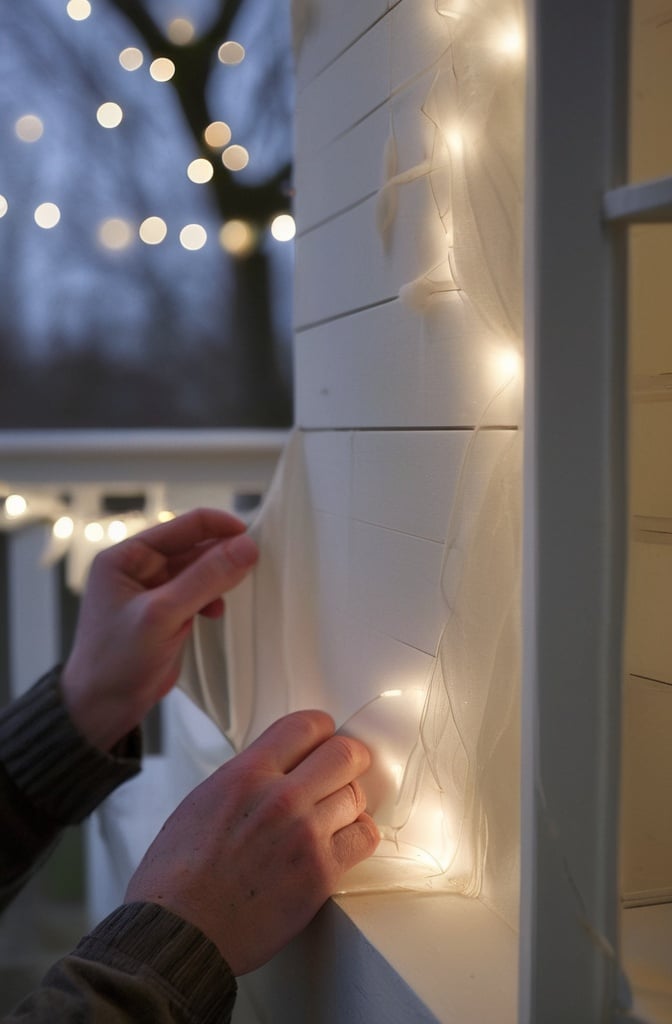
Even experienced decorators encounter challenges. Here are solutions to common problems:
Addressing Uneven Light Distribution
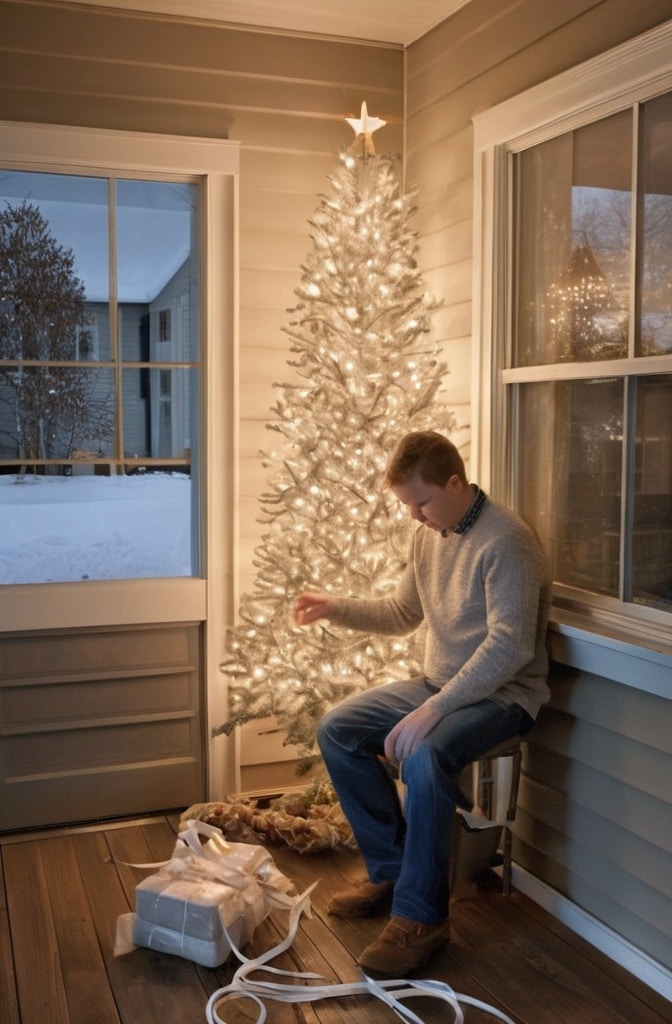
If your tree appears unevenly lit:
- Step back 10-15 feet and squint to identify dark spots
- Add supplemental lighting to underpopulated areas
- Redistribute ornaments to help reflect light into darker zones
- Consider the “triangle method”—divide your tree into triangular sections and ensure each has equal lighting
Fixing “Hot Spots” and Dark Areas
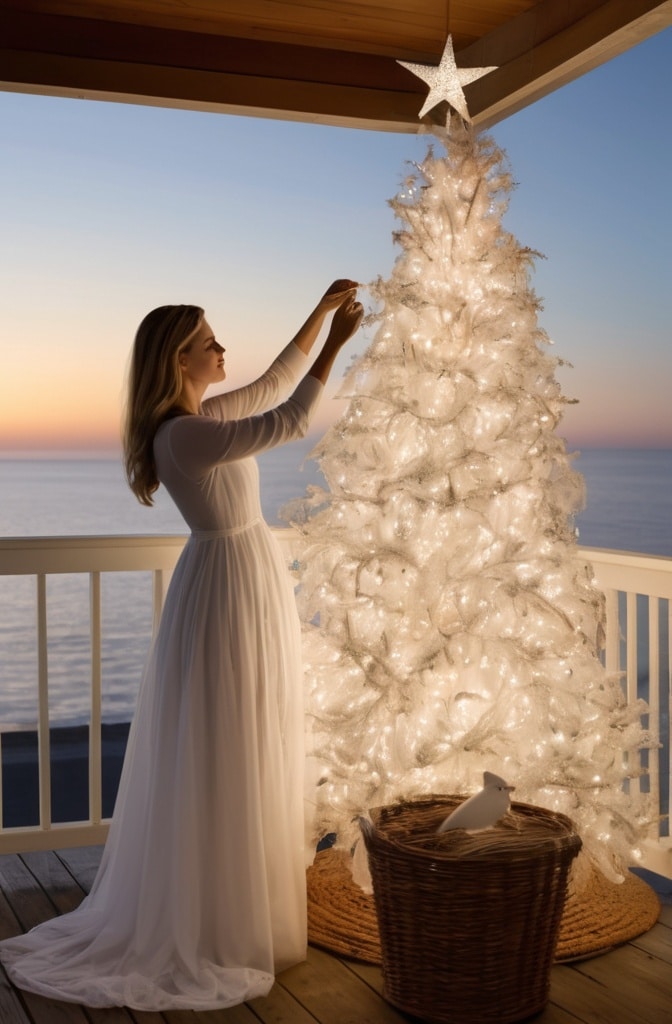
When certain areas appear too bright or too dark:
- Move some lights deeper into branches in overly bright spots
- Add reflective ornaments to dark areas
- Use larger ornaments to diffuse intense light points
- Incorporate ribbon or picks that can help spread light more evenly
Managing Cord Visibility
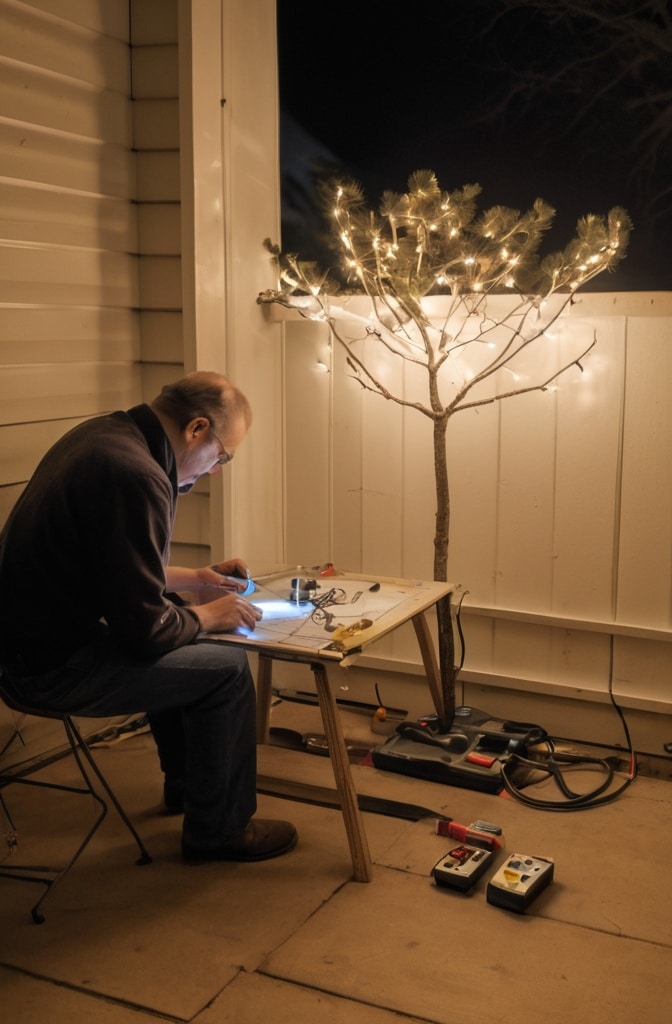
White trees often make cords more noticeable:
- Use white-corded lights specifically designed for white trees
- Twist and tuck cords around branches rather than letting them hang
- Position cords on the upper side of branches where they’re less visible
- Use floral wire to secure cords flush against branches in problem areas
Solutions for Keeping Lights Secure
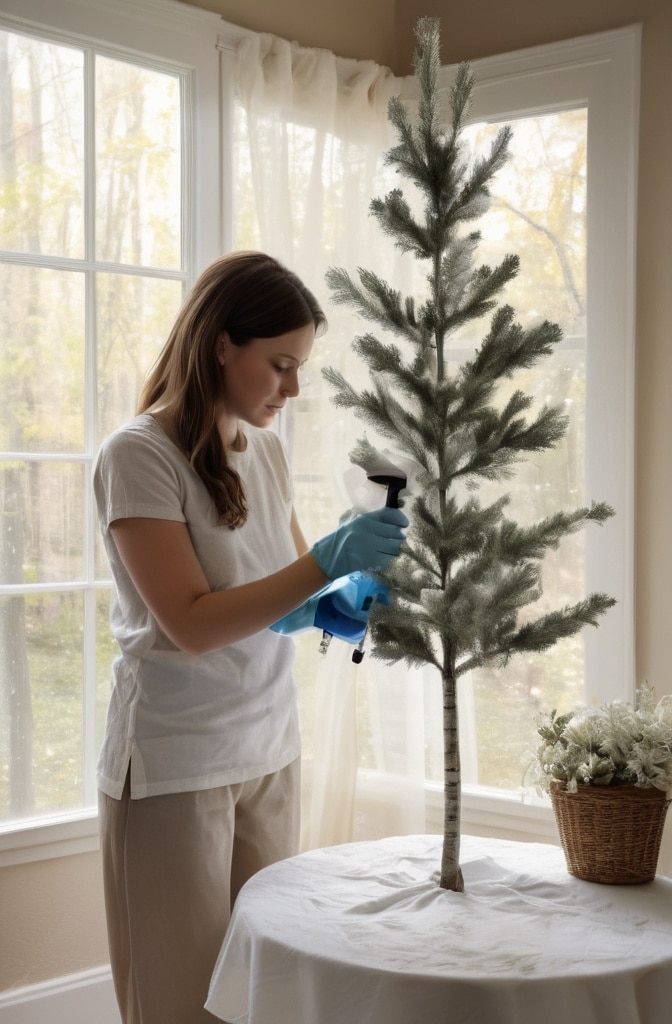
To prevent lights from slipping:
- Use small clear plastic clips designed for Christmas lights
- Secure with thin white pipe cleaners at key points
- Twist branch tips around light strands to anchor them
- Create small “stoppers” with floral wire at gravity points
X. Care & Maintenance Tips for Your White Christmas Tree
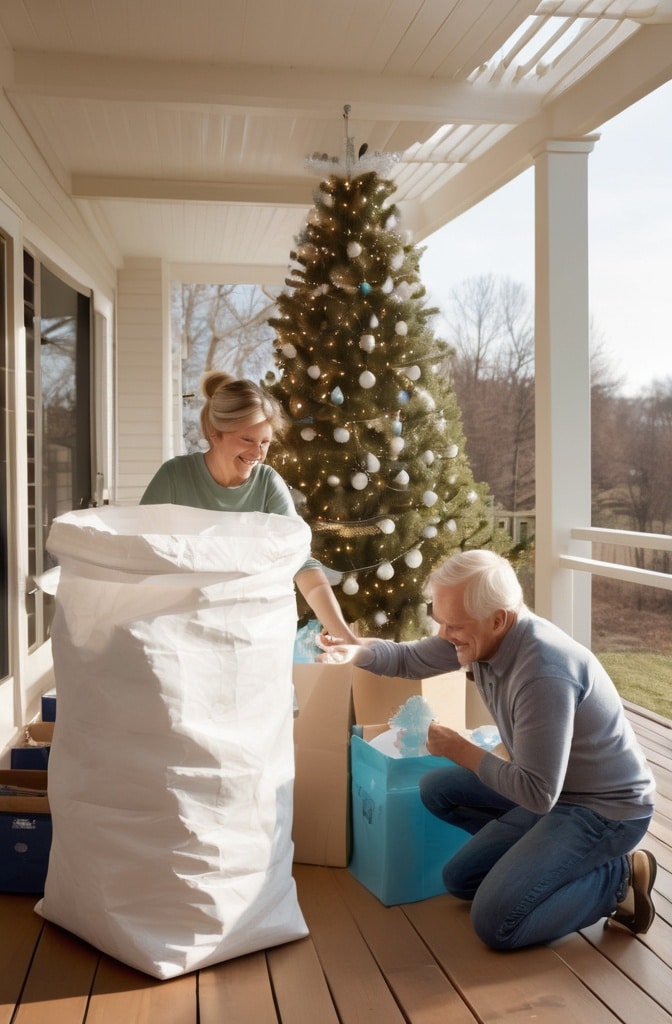
Protect your investment with proper tree care throughout the season and beyond.
Cleaning Techniques That Won’t Damage Lights or Branches
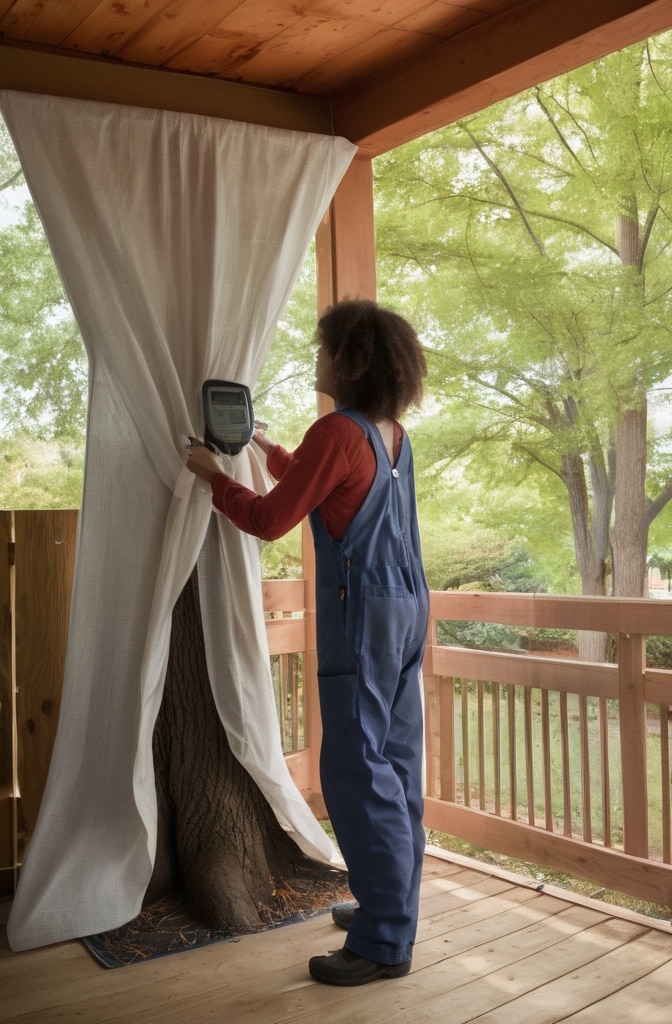
Keep your white tree looking pristine with these safe cleaning methods:
- Use a hair dryer on cool setting to blow dust from branches
- Gently vacuum with a brush attachment on low power
- Spot clean with a white microfiber cloth slightly dampened with water
- For stubborn marks, use a mixture of 1 part white vinegar to 3 parts water
Avoid commercial cleaners or feather dusters, which can leave residue or scratch delicate surfaces.
Proper Storage to Prevent Yellowing and Light Damage
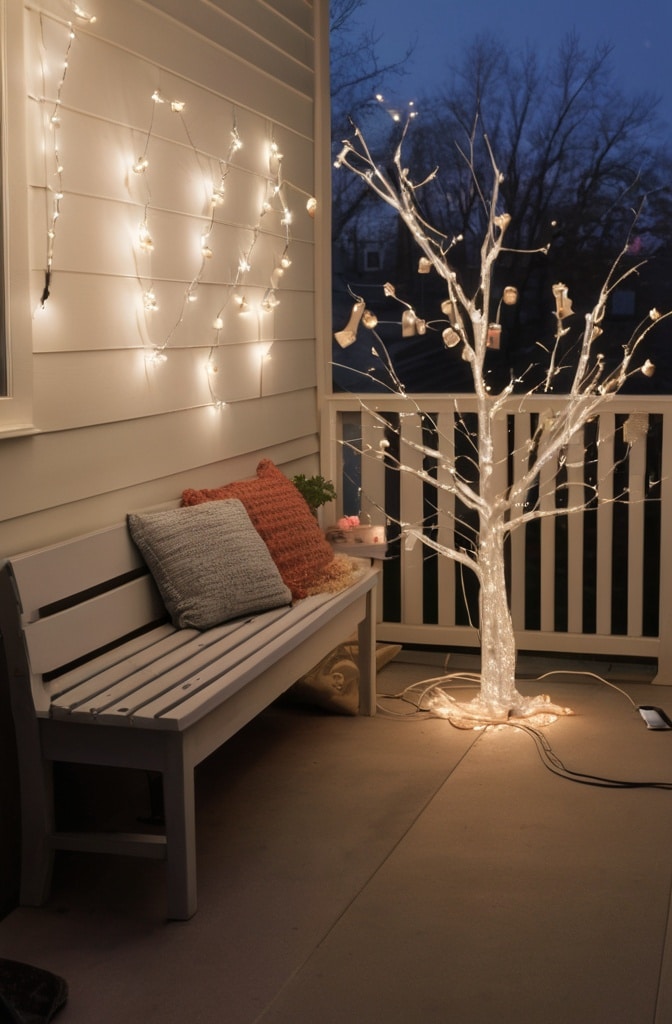
White trees require special storage consideration:
- Store in cool, dry locations away from direct sunlight
- Use white or clear storage bags rather than green or red ones that may transfer color
- Add silica gel packets to storage containers to absorb moisture
- Wrap tree sections in acid-free tissue paper before placing in storage bags
Some premium white trees use UV-resistant materials that resist yellowing, but proper storage remains essential for longevity.
Extending the Lifespan of Your Lights and Tree
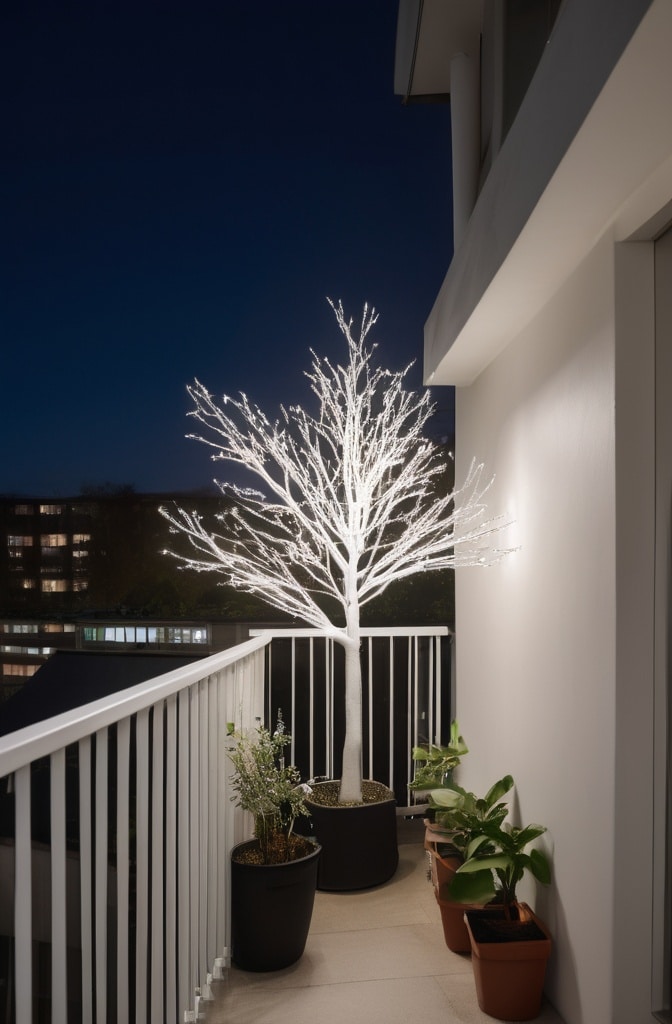
With proper care, quality Christmas lights and trees can last for many seasons:
- Turn tree lights off when not in use to prevent heat buildup
- Consider timers to automatically manage light cycles
- Handle branches gently when decorating and storing
- Replace individual bulbs promptly to prevent circuit overload
Quality LED Christmas lights should last 10+ seasons with proper care, while premium artificial white trees typically maintain their appearance for 7-10 years.
Energy-Saving Tips for Continuous Display
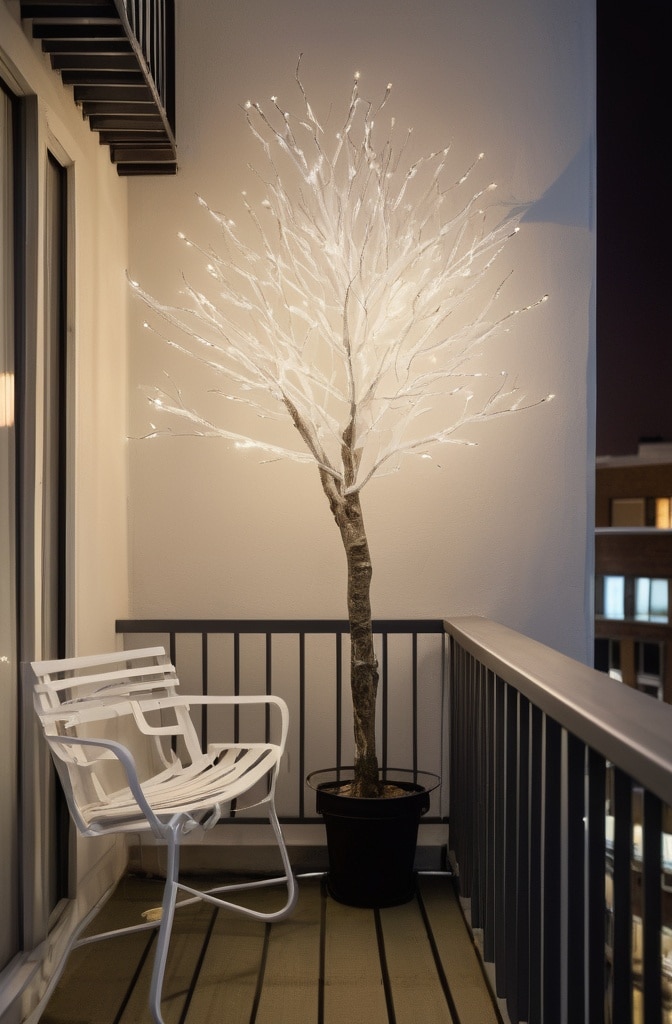
Minimize energy consumption while maximizing enjoyment:
- Use timers to automatically turn lights on for 6-8 hours daily
- Consider LED lights, which use up to 80% less energy
- Reduce other room lighting when tree is illuminated
- Use smart plugs to control tree lighting remotely and monitor energy usage
The average LED-lit Christmas tree costs approximately $10-15 to operate for the entire holiday season, compared to $50-80 for traditional incandescent lights.
Conclusion: Creating Your Signature White Christmas Tree Style
The beauty of a white Christmas tree lies in its versatility as a canvas for your personal holiday vision. Whether you prefer the timeless elegance of warm white and gold, the contemporary appeal of cool white and silver, or the sophisticated simplicity of minimalist design, your white tree can become a signature expression of your holiday style.
Research from environmental psychology suggests that thoughtfully decorated holiday environments can significantly impact emotional wellbeing. A beautifully lit white tree not only creates a stunning focal point but can actually help counter seasonal affective disorder by providing warm, ambient lighting during the darkest days of the year.
As you apply the techniques in this guide, remember that the most meaningful trees incorporate elements of personal significance alongside design principles. Consider adding one new special ornament each year, incorporating family heirlooms, or developing your own unique styling tradition.
We’d love to see your white Christmas tree creations! Share your photos on social media with #ClassicWhiteChristmasTree and tag us to be featured in our annual holiday gallery.
Bonus Section: Expert Q&A
Q: How many lights should I use if my white tree will be placed in a very bright room?
A: In well-lit spaces, increase your light count by approximately 30-40% to ensure adequate impact. Consider using lights with larger bulbs (C6, C7, or C9) rather than mini lights for greater visibility. Position the tree away from direct sunlight and consider using twinkle or motion effects to make lights more noticeable.
Q: Can I mix warm and cool white lights on the same tree?
A: While traditionally avoided, intentionally mixing light temperatures can create interesting depth. Try using cool white lights for the inner branches and warm white for the outer branches, or vice versa. This creates a subtle dimensional effect that’s become increasingly popular among professional decorators.
Q: What’s the best way to store a pre-lit white tree without tangling the built-in lights?
A: When disassembling, avoid twisting or pulling branches in ways that strain light connections. Store each section in its own storage bag, positioning them so lights aren’t crushed. Some decorators wrap each tree section in plastic wrap before storage to keep branches and lights compressed without tangling.
Q: Are flocked white trees more difficult to light properly?
A: Flocked trees actually diffuse and reflect light more effectively than non-flocked varieties, often requiring 15-20% fewer lights. However, be aware that the flocking material can sometimes flake off over time. When lighting a flocked tree, be particularly careful not to disturb the flocking by roughly handling branches.
